October 30, 2018
Boston Early Music Festival Chamber Opera to Present Caccini’s Alcina
Cambridge, MA – The GRAMMY Award-winning Boston Early Music Festival Chamber Opera Series returns on Thanksgiving weekend with an all-new production of the first opera by a woman composer, Francesca Caccini’s Alcina. Alcina is a brilliant entertainment, full of wit, magic, and drama, with a demanding title role first sung by the composer herself. The production will receive four performances: Saturday, November 24 and Sunday, November 25 in Boston, and Monday, November 26 and Tuesday, November 27 in New York City.
“Women have been shaping the world of opera from the very beginning, and we at BEMF are excited to present a new production of the first opera by a female composer, Francesca Caccini’s 1625 La liberazione di Ruggiero dall’isola d’Alcina ,” offers Executive Director Kathleen Fay. “As more and more women are finding their voice in opera, whether as artists, producers, patrons, or composers, it is exciting to be reminded that this is not a new phenomenon. We have been here for nearly 400 years already, and we are only getting started!”
This groundbreaking work is brought to life by the all-star BEMF Vocal and Chamber Ensembles in a magnificent production featuring gorgeous costumes and elegant period staging. Led by BEMF’s GRAMMY-winning Musical Directors Paul O’Dette and Stephen Stubbs and Stage Director Gilbert Blin, the directorial team also features Concertmaster Robert Mealy, Dance Director Melinda Sullivan, Costume Designer Anna Watkins, and Executive Producer Kathleen Fay. The dynamic cast of 15 singers features many BEMF favorites, including Canadian soprano Shannon Mercer (Alcina), praised for “ the lyric beauty and surprising power of her voice” ( Salt Lake Tribune); tenor Colin Balzer (Ruggiero), a frequent guest of BEMF’s Centerpiece Opera productions and recordings; and mezzo-soprano Kelsey Lauritano (Melissa), who made her début with the BEMF Orchestra at the June 2017 Festival. These superb vocalists appear alongside the twelve-member BEMF Chamber Ensemble.
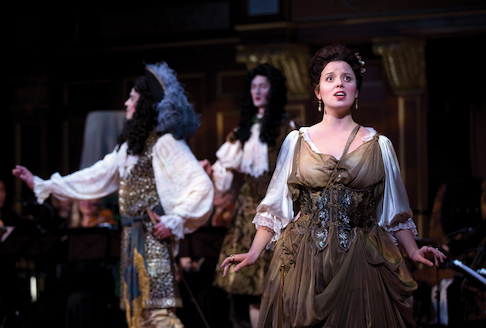
A contemporary of Monteverdi and a colleague of Galileo, Francesca Caccini came of age in Florence during the earliest years of opera as an art form. Both a composer and a performer, she was one of the most important musical figures at the Medici court during the regency of Christina of Lorraine and Maria Maddalena. In 1625, amid this time of female leadership, she created Alcina, the first opera by a woman composer and among the first Italian operas performed outside of Italy. Adapted from Ludovico Ariosto’s 16th-century epic poem Orlando furioso, the sorceress Alcina stands at the center of a struggle between illusion and destiny as the valiant Melissa strives to save the warrior Ruggiero and liberate the captives Alcina has transformed into plants and trees to ornament her island.
ARTISTS:
Boston Early Music Festival Chamber Opera Series
Paul O’Dette & Stephen Stubbs, Musical Directors
Gilbert Blin, Stage Director
Robert Mealy, Concertmaster
Melinda Sullivan, Dance Director
Anna Watkins, Costume Designer
Kathleen Fay, Executive Producer
Boston Early Music Festival Vocal Ensemble
Shannon Mercer, Alcina
Colin Balzer, Ruggiero
Kelsey Lauritano, Melissa
Teresa Wakim, Margot Rood, Sonja DuToit Tengblad, Danielle Sampson, Sophie
Michaux, Mindy Ella Chu, Jason McStoots, Brian Giebler, David Evans, David
McFerrin, Ian Pomerantz & Daniel Fridley
Boston Early Music Festival Chamber Ensemble
Paul O’Dette & Stephen Stubbs, chitarrone & Baroque guitar
Robert Mealy & Julie Andrijeski, violin
Sarah Darling, viola
Erin Headley, Christel Thielmann & Laura Jeppesen, viola da gamba
Kathryn Montoya & Héloïse Degrugillier, recorder
Maxine Eilander, Baroque harp
Michael Sponseller, organ, regal & harpsichord
WHEN:
Saturday, November 24, 2018 at 8pm
Sunday, November 25, 2018 at 3pm
New England Conservatory’s Jordan Hall, 30 Gainsborough Street,
Boston, MA
Monday, November 26, 2018 at 7:30pm
Tuesday, November 27, 2018 at 7:30pm
Gilder Lehrman Hall at the Morgan Library & Museum
225 Madison Avenue at 36th Street, New York, NY
PROGRAM: Francesca Caccini’s Alcina
TICKETS: Tickets for the Boston performances are priced at $25, $45, $55, $75, and $125 each, and can be purchased at www.BEMF.org and 617-661-1812; as well as through the Jordan Hall Box Office located at 30 Gainsborough Street in Boston and by telephone at 617-585-1260; a $5 discount for students, seniors, and groups is available by calling 617-661-1812. Subscription discounts are available with the purchase of three or more programs on the 2018-2019 Season.
Tickets for the New York performance are priced at $55 for Morgan members and $65 for non-members, and can be purchased at www.themorgan.org/bemf and at 212-685-0008 ext. 560.
ASSOCIATED EVENTS:
There will be a Pre-Opera Talk with members of the directorial team one hour prior to each performance in Boston, and one half-hour prior to each performance in New York.
RESOURCES:
Download artist photos: http://www.bemf.org/pages/press/images.htm
BEMF’s 2018–2019 Season Press Release: http://www.bemf.org/pages/press/071618_1819season.htm
ABOUT THE BEMF CHAMBER OPERA SERIES:
Hailed by the Boston Globe for “vivid performances,” since 2008 the BEMF Chamber Opera Series has taken the internationally acclaimed musicianship, scholarship, and direction showcased in BEMF’s fully staged Festival operas and focused it on small-scale works in intimate productions each Thanksgiving weekend. Two productions from the Chamber Opera Series have also been presented on tour across North America: Handel’s Acis and Galatea in 2011 and Charpentier’s La Descente d’Orphée aux Enfers and La Couronne de Fleurs in 2014. BEMF’s studio recording of Charpentier’sLa Descente d’Orphée aux Enfers and La Couronne de Fleurs was awarded the 2015 GRAMMY Award for Best Opera Recording.
ABOUT THE MORGAN LIBRARY & MUSEUM:
The Morgan Library & Museum began as the private library of financier Pierpont Morgan, one of the preeminent collectors and cultural benefactors in the United States. Today, more than a century after its founding, the Morgan serves as a museum, independent research library, musical venue, architectural landmark, and historical site. Located at Madison Avenue and 36th Street, its collection includes world-renowned collections of drawings, literary and historical manuscripts, musical scores, medieval and Renaissance manuscripts, printed books, photography, and ancient near Eastern seals and tablets. Gilder Lehrman Hall, designed by renowned architect Renzo Piano, was opened by the Morgan in May 2006, and seats 264 people, providing a uniquely intimate concert venue. This marks the Boston Early Music Festival’s 13th season of concerts at the Morgan Library & Museum.
ABOUT THE BOSTON EARLY MUSIC FESTIVAL:
Recognized as the preeminent early music presenter and Baroque opera producer in North America, the Boston Early Music Festival (BEMF) has been credited with securing Boston’s reputation as “America’s early music capital” ( The Boston Globe). Founded in 1981, BEMF offers diverse programs and activities, including one GRAMMY Award-winning and four GRAMMY Award-nominated opera recordings, an annual concert series that brings early music’s brightest stars to the Boston and New York concert stages, and a biennial week-long Festival and Exhibition recognized as the “world’s leading festival of early music” ( The Times, London). The 20th Boston Early Music Festival will take place from June 9–16, 2019, and feature the fully staged North American premiere of Agostino Steffani’s Orlando as the Centerpiece Opera. BEMF’s Artistic Leadership includes Artistic Directors Paul O’Dette and Stephen Stubbs, Opera Director Gilbert Blin, Orchestra Director Robert Mealy, and Dance Director Melinda Sullivan.
The 2018-2019 Boston Early Music Festival Concert Series is presented with support from the Massachusetts Cultural Council, National Endowment for the Arts, WGBH Radio Boston, and Harpsichord Clearing House, as well as a number of generous foundations and individuals from around the world.
For more information, images, press tickets, or to schedule an interview, please contact Kathleen Fay at 617-661-1812 or email kathy@bemf.org.
image=http://www.operatoday.com/BEMF%20Versailles%20Chamber%20Opera%20-%20Kathy%20Wittman%20credit.jpg image_description=Photo by Kathy Wittman courtesy of Boston Early Music Festival Chamber Opera product=yes product_title=Boston Early Music Festival Chamber Opera to Present Caccini’s Alcina product_by=Press release by Boston Early Music Festival Chamber Opera product_id=Photos by Kathy Wittman courtesy of Boston Early Music Festival Chamber OperaOctober 28, 2018
Complementary Josquin masses from The Tallis Scholars
For, Peter Phillips, the Tallis Scholars’ founder (in 1973) and director, has chosen to pair the Missa Gaudeamus, based on the introit ‘Gaudeamus omnes in Domine’, with the Missa L’ami Baudichon which draws upon a secular song, notable for its textual lewdness: a reference to female genitalia in the French language text is excised in the only source to present the text, now held in Verona.
In his CD liner note, Phillips explains that the Gaudeamus cantus firmus is associated with All Saint’s Day from which it derives it liturgy, a view proposed - not without dispute by other scholars - by Willem Elders in his Studien zur Symbolik in der Musik der alten Niederlander (1968) and Symbolic Scores: Studies in the Music of the Renaissance (1995).
Further, the Missa Gaudeamus, which is assumed to date from the composer’s middle period of the mid 1480s (though it is documented only in Petrucci’s first book of masses in 1502), is said by Elders to be permeated by ‘hidden’ and mystical numerical ‘codes’. These will probably be seldom detectable or of little import to the listener. What will undoubtedly strike the ear more emphatically is the resonant ambience of the initial articulation of the chant - the engineers having exploited the sonorous acoustic of the College of Merton College Oxford - which, cascading in inspiring echoes from the Chapel’s walls, windows and alcoves seems designed to inspire the fervent, flowing drive of the Kyrie and subsequent movements.
Josquin seldom states the whole chant, excepting the Gloria and Credo where it is embellished in the tenor; instead, snatches of the first six notes which are characterised by an aspiring, invigorating ascending leap of a ‘pure’ 5th, infiltrate the music, sometimes suggesting a sweeping, spacious expanse, sometimes ‘filled in’ with stepwise melodic movement.
The effect is a homogeny of gesture - and on this recording, of timbre, dynamics and mood also - which at times exerts a hypnotic, magnetic tug and elsewhere seems a little unalleviated. This listener was swept up in the mellifluous precision - of intonation, vocal entries, rhythmic interplay - and forward drive of the Tallis Scholars’ committed rendition, Phillips adopting swift tempi and pushing fervently onwards. But, I longed at times for a little more dynamic contrast, both within and between phrases, and timbral variety. The latter comes not through expressive or devotional interpretation but only when Josquin reduces and varies his forces: most notably in the Sanctus and Benedictus where the light and airy three-voice (SAB) ‘Pleni sunt caeli’ takes off in the first ‘Hosanna in excelsis’, as if a multitude have been inspired to ecstatic worship by such lucid devotion. Similarly, the sparse counterpoint of the Benedictus, which intimates a gravity sometimes absent elsewhere, is followed by a second ‘Hosanna’ of secure and assuring faith. Likewise, the dynamic cross-rhythms of the opening Kyrie are succeeded by the ambiguous, fervently rhapsodic weak-beat entries of the Christe, before being cleansed by the sparser textures of the second Kyrie episode.
Not every such opportunity for such contrast is taken up: the ‘Qui tollis’, following the vibrant Gloria, opens with the two lower voices moving in slower rhythmic values, but Phillips pushes ever forwards. I think that a little more spaciousness and pause for reflection would, occasionally, have been advantageous, though it’s certainly the case that the excited ebb and flow of voices in the Gloria creates real ardency and energy, and the move from duple to triple meter for the concluding ‘Cum Sancto spiritu’ and ‘Amen’ is wonderfully persuasive and uplifting.
It is the Credo that is most compelling, though, as Josquin floods the voices with florid but elegant developments of the cantus firmus and pushes the higher three voices ever upwards; again, I’d have liked a little more spaciousness here - for example during the textural contrasts of the repetitions of ‘omnia secula’, where the relentlessness can obscure the rhetorical power of individual utterances - though it is true that the overlapping entries have a mesmeric power. And, as ‘Et resurrexit’ in the ‘Et incarnatus’ episode pushes forward one feels that sound is prioritised over text. ‘Et unam sanctum’ follows with barely a pause or breath, though Phillips does permit and welcome, enrichening broadening in the final Amen.
The overall vocal balance is controlled, though the soprano entries sometimes sound rather too dominant (interestingly, Elders notes, the discantus part of the Missa Gaudeamus, in common with Josquin’s two other Masses in honour of Our Lady, is written wholly in the G clef, suggesting the use of boys’ voices). Moreover, the flattening of particular pitches within the modes does not seem to be a consistently applied principle.
But, Phillips structures the Agnus Dei persuasively: the second repetition of the text - sung by the overlapping, intertwining, dialoguing soprano and alto soloists - is a lovely palette cleanser for the final, sombre statement in which the alto descends to serious depths, carried downwards by the same scalic motifs which raise up the heaven-bound soprano.
There’s nothing very heaven-bound, one might think, about the Missa L’ami Baudichon: in pre-7th century French ‘baud’ means joyful and it is commonly assumed that ‘Baudichon’ is the nickname for a ‘lusty swaggering youth’. But, if the text derives from the secular, the music seems to strive for the divine and infinite. This is usually considered to be one of the earliest of Josquin’s Mass settings, although the attribution has been doubted: David Fallows, for example, has suggested that the extensive duos are more indicative of Dufay’s writing than that of Josquin, concluding (in his 2009 book), ‘I really do not believe this can be a work of Josquin: logic aside, it simply feels to me wrong, even though it has more than its fair share of truly marvellous moments’.
And, ‘marvellous moments’ there are in plenty. The richness of resounding organ stops seems to lift the start of the Kyrie, the simple descending melody - not unlike ‘Three Blind Mice’ - borne aloft with a broadness and expanse missing in the Missa Gaudeamus. And, the Tallis Scholars seem inspired to more emotive and visceral expression. The vibrantly rolled ‘r’ in ‘Christe’ evinces real human devotion and passion, and the strong colour and energy of the bass line seems to lift the other voices: the sopranos have a lovely brightness and freshness, while the inner voices move with joyful vigour.
This sense of aspiration and confidence continues in the Gloria, where initially the soprano and bass lines endeavour in complementary fashion, as if contouring the expanse of the heavenly spheres. When they are joined by the alto and tenor, the full choir radiates real human energy - all its glories and imperfections. The lack of elaborate contrapuntal (and numerical?) argument between the alto and bass in the ‘Qui Tollis’ is direct and affecting, and seems to inspire the singers to inject more individual colour into their respective lines, creating greater dynamic variety and a lively conversation. The ‘Cum sancto spiritu’ which closes the Gloria is invigorating and visceral in timbre, while the wide vistas of the Credo rove and roam, rhythmically energised, modally inflected.
Two duos articulate the ‘Et incarnatus’ and ‘Crucifixus’ - by ST then AB respectively - before all four voices join together for ‘Et resurrexit’: and here, the opening bare fifth and subsequent homophonic richness are almost rudely confident and direct, though such features give way to lighter, tripping, decorative interjections, around the tenor’s bold, almost defiant, long-held notes. The Sanctus is similarly confident - harmonically and texturally ambitious - and resonantly sung. And, the experimentation and exploration in ‘Pleni sunt’ which temporally pits two in soprano against three in alto and inflects the invigorating lines with modal nuance, is responded to by all four voices with joyful brightness: ‘Hosanna’ indeed.
One might suggest that these two Masses are the work of different composers, but Phillips comments of the two ‘sound worlds: the one intensely worked, the other joyful, bright, easy-going’: ‘I would say genius on this scale knows no rules.’
This recording of Missa Gaudeamus and Missa L’ami Baudichon by the Tallis Scholars is released on 2nd November by Gimell.
Claire Seymour
image=http://www.operatoday.com/Gimell%20Josquin.jpg image_description=Gimmell CDGIM 050 product=yes product_title=Josquin Masses – Missa Gaudeamus and Missa L’ami Baudichon product_by=The Tallis Scholars, directed by Peter Phillips product_id=Gimmell CDGIM 050 [CD] price=$19.98 product_url=https://amzn.to/2Q0doD2
Piotr Beczała – Polish and Italian art song, Wigmore Hall London
The two parts of the programme reflected two aspects of Beczała's artistic persona. As an opera singer, he has sung in Italian, German, French, Russian, Czech and Polish. The Italian songs he chose for this occasion showed the dramatic possibilities in art song - art song for opera singers, vehicles for technique and expressiveness. The programme began with three songs from 36 Arie di stile antico by Stefano Donaudy (1879-1925), a Sicilian contemporary of Puccini's, which were taken up soon after publication by singers like Caruso and Tito Schipa. Beczała's crisp diction made Freschi luoghi, prati aulenti sparkle, contrasting well with the darker O del mio amato ben. Followed by four songs from 8 rispetti by Ermanno Wolf-Ferrari (1876-1948). Although Ottorino Respighi wrote operas, he also composed a substantial body of orchestral and chamber music. The songs on this programme thus represent an approach to art song which favours the more private, personal medium of voice and piano. The songs of Paolo Tosti (1846-1916)served as a bridge between Donaudy and Wolf-Ferrari and Respighi.
The second part of the programme focused on Beczała's Polish roots. Throughout his career, he has made a point of promoting Poland's rich musical heritage. He sang The Shepherd in Karol Szymanowski's Król Roger in the 2003 Warsaw production, and has also done many of the composer’s songs for male voice. For this Wigmore Hall recital Beczała chose Szymanowski's Sześć pieśni (Six Songs), his op 2, completed when he was still a student, aged 18. Significantly, all are also settings of living poets, contemporaries of the composer. Although Szymanowski was to make his name as a cosmopolitan sophisticate, these songs show that his Polish identity went deep. The texts here were by Kazimierz Przerwa-Tetmajer (1860-1940) . Przerwa-Tetmajer was both a nationalist and modernist, given that Secessionism and Symbolism were forces for renewal, all over Europe. Each of these poems is brief, but the imagery is so concentrated that meaning is left deliberately elusive. The first two songs, in a minor key, are autumnal, but the strong piano part suggests resolve. In both songs, rise the image of a woman who may no longer exist. With the third song, We mgłach (In the Mist) the vocal line curves mysteriously, like the mists and streams in the evening cool. What's happening ? "Bez dna, bez dna! bez granic!" sings Majzner, (No bottom, no bottom, without borders!). In dreams, the poet hears mysterious voices calling . In the last song, Pielgrzym, the line rises, swelling with hope. "Gdziekolwiek zwrócę krok, wszędzie mi jedno, na północ pójdę, czyli na południe", (Everywhere I turn, from the north I will go south) Immediately one thinks of the Persian Song of the Night in Szymanowski’s Symphony no 3 and in the Shepherd in the opera Król Roger whose singing changes the King's life.
Mieczław Karłowicz (1876-1909) and Szymanowski were influenced by the Young Poland movement, a literary and artistic aesthetic not dissimilar to the Secession in Munich and Vienna, but with specifically nationalist elements. Pointedly, Beczała and Deutsch paired the early Szymanowski songs with Karłowicz's settings of poems by the same Kazimierz Przerwa-Tetmajer . Indeed, both set the same text, Czasem, gdy długo na pół sennie marżę (Sometimes when long I drowsily dream) which describes a strange, disembodied voice, heard in a dream. "I do not know if this is love, or death, that sings" . The piano part in Karłowicz's version is particularly sophisticated, suggesting perhaps Liszt or Chopin, though the style is distinctively fin de siècle. In Na spokojnnym, ciemnym morzu (On the calm, dark sea) (op3 no 4 1896) the poet imagines sinking into oblivion. "Let me revel in Nothingness". In recitals, reading the text while listening is not a good idea. You might get the words, but you cut yourself off from nuance and musical truth. Much, much better to concentrate on singer and pianist and use your intuition. Because Beczała and Deutsch are so very good at what they do, intuitive listening was surprisingly accurate. The moody piano part suggested strange dissonance, and the edge in Beczała's voice suggested psychic anomie. The stillness in W wieczorną ciszę (In the calm of the evening) (op3 no 8) is ominous. Again, the poet disassociates from the world. perishing "in the dark emptiness". The Przerwa-Tetmajer texts are so surreal that they evoke very fine expression from Karłowicz. Ironically, the composer died young, killed while skiing in the mountains.
Also from Karłowicz's op 3 are the songs Przed nocą wieczną (Before eternal night) and Zaczarowana królewna (The Enchanted Princess) settings respectively of Zygmunt Krasinski and Adam Asnyk, receiving relatively more straightforward treatment from the composer, but as evocatively performed by Beczała and Deutsch. Beczała has appeared in several Polish operas, including Stanisław Monicuisko's Halka and Straszny dwór (The Haunted Manor) - please read about that here. After the intensity of the very beautiful Karłowicz songs, the Monicuisko songs were rather more down to earth. Monicuisko (1819-1872) reflected an earlier aesthetic than that of Karłowicz : more nationalistic, closer to Smetana than to the world at the turn of the 20th century. Thus robust songs about sweethearts and spinning wheels, complete with atmospheric piano figures, and Polna różyczka so vividly sung by Beczała that it was instantly recognizable as a setting of Goethe's Heidenröslein, without needing translation. Then Monicuisko's Krawkowiaczek (The Krakow Boy) who fools around but loves only Halka. For an encore, another wonderful Karłowicz song The Golden years of Childhood. "It's my favourite" said Beczała : almost as well crafted as the Przerwa-Tetmajer songs but warmer and cheerier.
Anne Ozorio
image=http://www.operatoday.com/Beczala-Piotr.jpg
image_description=Piotr Beczała [Photo by Johannes Ifkovits]
product=yes
product_title= Piotr Beczała, Helmut Deutsch, Polish and Italian art songs, Wigmore Hall, London, 22nd October 2018
product_by=A review by Anne Ozorio
product_id=Above: Piotr Beczała [Photo by Johannes Ifkovits]
Soloists excel in Chelsea Opera Group's Norma at Cadogan Hall
The young Richard Wagner, writing in Heinrich Laube’s Zeitung für die elegante Welt during the 1830s, suggested that German composers should look to learn from the Italians, and particular from the flowing vocal melodies and bel canto expressiveness of Bellini, whom he affectionately nicknamed ‘the gentle Sicilian’. Perhaps less surprisingly, Tchaikovsky, having read the first biography of Bellini, wrote to a friend, “I have always felt great sympathy towards Bellini. When I was still a child the emotions which his graceful melodies, always tinged with melancholy, awakened in me were so strong that they made me cry”.
Despite being standard repertory fare in the 1950s and ’60s, subsequently Norma fell out of favour, perhaps because of the fearsome demands it makes upon the soprano brave enough to embody the titular Druid priestess in all her roles - leader, mother, lover. 2016 was, though, ‘ Norma year’ in London, with ENO staging their first ever production of Bellini’s bel canto masterpiece in February and the ROH presenting the first production at Covent Garden for almost 30 years in September.
Now, Chelsea Opera Group, who tackled Bellini’s I Capuleti e I Montecchi in 2014, have mounted a concert performance of Norma. And, if I had any doubts about the wisdom of this repertoire choice, not just because of the challenging writing for the soloists but also because the choruses, though energetic, are not great in number, then these were immediately and absolutely swept away by the stunning performances of the principals - two of whom, like conductor Dane Lam, have Australian origins or links - at Cadogan Hall.
Sopranos who are equipped to follow in the path of Guiditta Pasta, Lilli Lehmann, Rosa Ponselle, Callas and Joan Sutherland, to name but a few illustrious exponents of the role, may be rare, but Helena Dix is undoubtedly one of those with the vocal and expressive qualities to climb to the summit of this operatic Everest. The star of Wexford Festival Opera’s award-winning 2013 production of Jacopo Foroni’s Cristina, Regina di Svezia , her lyric soprano is silky and soars effortlessly. As Cristina, Dix’s poise and dignity were much in evidence in the ceremonial scenes and she brought such gravitas and authority to her role here, establishing the emotional profundity and maturity of the Druid priestess. She was a noble presence, by turns vulnerable and authoritative, her utterances sincere but also at times portentous. We saw a relaxed and caring Norma, in her duet when Adalgisa at the start of Act 2, when the women come together in feminine unity. Her maternal love and distress touched our hearts as she pleaded with her father, Oroveso, to spare her children from suffering and shame after her death.
Dix alternates her chest and head voice with ease and has a lovely clean-edged tone. She softened it beautifully for ‘Casta diva’, demonstrating stunning power, control and expansiveness of breath, to offer the requisite nuance. In the florid cabaletta, though, the Australian soprano released her voice in rapturous flights, gleaming lightly. Elsewhere, Norma’s anger drew forth a full, weighty sound which quelled both Adalgisa and Pollione in the trio at the close of Act 1, while tenderness was served by her beautiful pianissimo. She had the stamina to build towards the fortitude and sense of duty which dominate the close, and if Dix seemed to tire a little at start of Act 2 - some of the phrasing was ‘choppier’ - then she may have simply been saving herself for the final scena.
After Norma’s opening scene, I feared that we would not have an Adalgisa who could match Dix’s vocal authority. I need not have worried: Elin Pritchard’s rich soprano conveyed all the emotional urgency and vacillation of the youthful Adalgisa, who is not burdened with such vast responsibilities but who is driven by overpowering passions. The persuasive characterisation of Pritchard’s Adalgisa was enhanced by the fact that she had learnt the part well enough to sing almost entirely off-score throughout. I’ve seen two of Pritchard’s recent performances, and her Adalgisa confirmed her impressive dramatic and vocal range. It’s hard to imagine a role more different to the motorbike-obsessed Marie in Opera della Luna’s production of Donizetti’s The Daughter of the Regiment at Wilton’s Music Hall this summer; and, if she had had no trouble ascending to Marie’s high Es, then the luxurious richness of her middle register which had been so strongly in evidence during her performance as Miss Jessel in Regent Park’s The Turn of Screw once again made its mark. One sensed every atom of Adalgisa’s passion, anguish and guilt during this terrific performance.
I first enjoyed Christopher Turner’s firm lyric tenor in two of Bampton Classical Opera’s recent productions: Salieri's La grotta di Trofonio in 2015 and Gluck's Philémon e Baucis the following year. Currently performing in ENO’s Salome , here Turner was an unusually sympathetic Pollione, overcome by genuine strength of feeling, suffering rather than imposing cruelty on other. From the first, this Roman knew that he had been consumed by a higher force that could not be resisted, whatever tragedy would consequently and inevitably befall him and those he loved. In his opening cavatina, ‘Meco all’altar di Venere’, Turner’s recounting of Pollione’s terrifying dream was paradoxically both remorseful and determined. The tenor avoided over-exaggeration or mannerism but made good use of a convincingly Italianate ring and a ‘sob’ which was occasionally an effective, piercing frisson through the lyricism.
Australian-American bass Joshua Bloom was a thunderous Oroveso, sounding sonorously and magisterially from amid the Chorus: no Druid would surely dare to ignore Oroveso’s instruction to look out for the rising moon (‘Ite sul colle, O Druidi’), but Bloom effectively lifted his song from the choral sound, and allowed it to be re-subsumed. Despite the literal distance between father and daughter, the emotional threads that tie Norma and Oroveso were powerfully communicated at the close of Act 2. The minor roles of Pollione’s friend Flavio and Norma’s confidante Clotilde, were sung very competently by Adam Music and Claire Pendleton respectively.
And, so, what of the Chelsea Opera Group Chorus? Though the tenors were fairly few in number, the combined male forces made a vigorous and wholesome sound, and the full Chorus essayed a stirring War Hymn, invigorated by the relaxed and encouraging gestures of their conductor, Dane Lam. I was impressed by the fluid drama that Lam crafted; accelerations and changes of tempo were clearly and deftly indicated by the left-hander, and if the Orchestra of Chelsea Opera Group didn’t always follow his precise commands instantly, then Lam was untroubled and simply worked effectively to wind them up to the mark he had set. He conjured a true sense of grandeur and tragic intensity at the musical and dramatic climaxes, as well as tenderness in the intimate moments. His efforts were rewarded with solid orchestral playing: there was some expressive cello lyricism and in general the strings were much less ragged than they have sometimes been during past COG performances that I’ve attended. There was a real sense, too, that the instrumentalists were listening to the singers, and some particularly note-worthy flute playing from Ben Pateman. Tuning was generally good, though less secure in the quieter, slower passages where horns and brass were sometimes imprecise; and, I’d have liked more confident and forthright playing from across the whole woodwind section, to give their contributions more telling presence.
Perhaps inevitably, during this concert performance, in which the soloists were so striking and compelling, it was the passages of emotional intimacy that held sway over the vast national and religious conflicts. But, this was a good account of this quintessential bel canto gem, one which whetted my appetite for COG’s next two ventures into the rarer parts of the repertoire in the spring and summer of 2019 - Mefistofele by Boito in March and Anton Rubinstein’s The Demon - which will both be performed at the Queen Elizabeth Hall.
Claire Seymour
Bellini: Norma
Norma - Helena Dix, Adalgisa - Elin Pritchard, Pollione - Christopher Turner, Oroveso - Joshua Bloom, Flavio - Adam Music, Clotilde - Claire Pendleton; Conductor - Dane Lam, Chelsea Opera Group Chorus and Orchestra.
Cadogan Hall, London: Saturday 27th October 2018.
image=http://www.operatoday.com/helena-dix-cr-Grzegorz-Monkiewicz-800px.jpg image_description= product=yes product_title=Norma, Chelsea Opera Group at Cadogan Hall product_by=A review by Claire Seymour product_id= Above: Helena Dix (Norma)Photo credit: Grzegorz Monkiewicz
October 27, 2018
Handel's Serse: Il Pomo d'Oro at the Barbican Hall
But, the present-day doesn’t have a monopoly on narcissistic premiers and princes, and many historical prototypes seem to find their way into opera librettos of Baroque opera seria. Watching Argentine countertenor Franco Fagioli’s Serse, King of Persia, huff and puff, rant and rave, swagger and bluster during Il Pomo d’Oro’s concert performance at the Barbican Hall (which followed performances in Lubljana, Vienna and Paris), it was perhaps fitting that the image of Donald Trump’s baby blimp, which floated over the streets of London during the President recent UK visit, came to mind. For Handel’s Serse certainly is tragi-comic, to the chagrin of contemporary commentators such as Charles Burney: “One of the worst that Handel ever set to music”, bemoaned the music historian after the premiere of the opera at the King’s Theatre, Haymarket, on 15 th April 1738.
It’s worth remembering, though, that Burney was imposing the eighteenth-century taste for the repetitions and excesses ofopera seria on a libretto that had its roots in the seventeenth century - having been adapted by an unknown author from Silvio Stampiglia’s libretto for Giovanni Bononcini’s 1694 opera, Stampiglia’s text having itself been based on Nicolò Minato’s version of the Persian King’s antics for Francesco Cavalli in 1654. And, that the structures of the text set by Handel implied not an inexorable succession of rigid da capo arias but rather, as Handel supplies, a sequence of short airs of varied forms, which follow one another swiftly, often without ritornelli and little recitative.
Burney may have lamented the serio-comic tone of Handel’s Serse, but it was the “buffoonery” that he believed resulted in “feeble writing” which Il Pomo d’Oro frequently brought to the fore, sometimes at the expense of the music elegance of the score, and overlooking that Handel’s ironic twists on opera seria conventions and structures are more often witty and whimsical than rowdy or histrionic.
Fagioli encouraged us to mock Serse’s peevishness, infantilism and narcissism, thereby weakening our sense of the very real danger that such tyrants pose. The loyal Amastre was dismissed as a “perpetual nuisance” by the foot-stamping King in a frustrated fury, and when the upright Ariodate - whose own integrity prevented him from reading between the lines - took Serse at his word and betrothed his daughter, Romilda, to the wrong royal brother, I half expected a full-on ‘Red Queen’ hissy fit, “Off with his head!”, from the enraged monarch whose romantic plans had been thwarted.
The pace of Il Pomo d’Oro’s near-complete performance of the opera was fast, the dramatic flow of the seventeenth-century libretto structure pushed almost to excess. Musically there were benefits, the rapid sequence of songs seeming to spring spontaneously from the unfolding dramatic situations. But, the haste risked further undermining the ‘serious’ dimension of the drama and, given that the performers were in modern concert dress, perpetuating the perennial confusions and complications of the seria web of gender-crossing and disguise. The towering Jimmy Choo stiletto boots donned by Arsamene, sung by mezzo-soprano Vivica Genaux, and the ‘soldier’s uniform’ sported by Delphine Galou’s Amastre - a long black cardigan over a sparkling, back-less evening gown, might have had uninitiated audience members scratching their heads as to who was who, related to whom, on what basis their schemes and stratagems had been borne.
Despite this, although billed as a concert performance, the cast made a concerted effort to communicate the action, often singing confidently off-score, and carrying off the carefully choreographed exits and entrances. Moreover, not a single person present in the Barbican Hall could surely have failed to be bowled over by Fagioli’s dramatic commitment and acrobatic musical accomplishments. This was a truly ‘lived’ performance, physically and vocally. The soprano-like punch and precision at the top; the striking agility which spun reams and curlicues on a single, long breath; the ability to leap with accuracy and evenness across wide expanses - even venturing down into his bass voice before leaping back to his shining countertenor; all such feats were mesmerising.
‘Se bramate’ and, most especially, ‘Crude furie’ were electrified by explosive elaborations and ornamentations. Though such extravagance was undoubtedly impressive, initially I felt that the pyrotechnics resulted in a distortion of the phrasal, cadential and formal balance; but, the technical daring was, by the close, simply hypnotic - a thrilling, breath-taking expression of the King’s solipsistic immaturity. Perhaps Fagioli was striving to embody the overweening arrogance not just of the Persian premier but also of the role’s first interpreter, the soprano castrato Caffarelli - described by his teacher, Porpora, as “the greatest singer Italy had ever produced”, who was notoriously unpredictable and even served a spell in prison for assault. If so, he succeeded in resurrecting the castrato’s temper and tantrums, even if he did not revive the legendary refinement of Caffarelli’s liquid legato which Handel exploited in his slower airs. ‘Ombra mai fù’, though pure of tone, felt rather rushed, and the pathos of line in ‘It core spera e teme’ was lost in the floridity of the ornamentation. A little more simplicity at times would have bestowed equal weight on the sincerity of Handel’s music as on the drama’s comic excesses.
Fagioli’s exhilarating performance was far from being the only vocal delectation of the evening. As Romilda, Inga Kalna repeatedly coaxed beauty and expanse from Handel’s phrasing: that she had plenty of power in reserve enabled her to spin the most gossamer piano threads, as when expressing her love in ‘Nemmen con l’ombre’, and if there was a danger that such gestures might become a mechanical mannerism, then Kalna balanced delicacy with a sonorous, creamy tone which was effortlessly projected, most especially in ‘Chi cede al furore’, and flashes of fire in her vigorous Act 3 duet-argument with Genaux’s Arsamene, ‘Troppo oltraggi la mia fede, alma fiera’.
Genaux’s lower register did not project as well as her soprano range, but she offered much stylish singing and her performance grew progressively in stature. In so persuasively articulating the contrast between the pained pathos of ‘Quella che tutta fé’ and the impassioned hurt of ‘Sì, la voglio’, Genaux made Arsamene’s suffering one of the more convincingly tangible ‘human’ experiences of the evening.
Contralto Delphine Galou gave a similarly tasteful and composed performance as Amastre, and if the gentle warmth of her voice didn’t always carry effectively across the Hall, she showed terrific agility in her vengeful ‘Saprà delle mie offese’ in Act 1, and grace of line in the sparsely accompanied final cavatina, ‘Cagion son io’.
Much of the evening’s warmest humour came courtesy of the mischievous, insouciant wilfulness of Francesca Aspromonte’s Atalanta and the Mozartian directness of Biagio Pizzuti’s Elviro. Aspromonte’s lovely rich tone made this Atalanta a more sympathetic and forgivable character than is sometimes the case. Resourceful and resilient, despite her stated romantic intentions Atalanta could not resist ‘vocally flirting’ with leader Evgeny Sviridov, who was more than happy to respond with his own brief serenade, and at the close she shrugged off the failure of her romantic stratagems, declaring herself ready to look for love elsewhere - and catching the opportunistic Elviro’s eye in the process.
Pizzuti almost stole the show in a minor role to which he brought terrific comic presence - and considerable vocal style. Disguised, somewhat improbably, as a flower seller, in a flamboyant purple head-scarf, and a little encumbered by his large music score and plastic bouquet, Pizzuti was an engaging stooge, creeping around the instrumentalists, hamming wickedly to Katrin Laza’s colourful bassoon playing; his final aria, ‘Del mio cara baco amabile’, was a smooth and suave paean to Bacchanalian indulgence and relaxed revelry. Andreas Wolf’s Ariodate was no less impressive: his powerful, focused bass sailed through the vocal phrases with easy projection, terrific diction and even tone. It was quite a feat for Wolf to convey both the warrior’s haplessness amid the amorous machinations off the battlefield and his accomplishment at manoeuvres in the field. One could truly sympathise when his exasperated expression conveyed all of his exhaustion and incredulity: Oh, for the quiet life of soldiering!
This was a meticulous prepared performance. Director Maxim Emelyanychev was an almost hyperactive and vigorously gestural guide, striving unceasingly to coax the most energetic tone from his small band of instrumentalists and precisely pointing the minutest of accents, swells and surges. In command of every detail, he gave encouragement with whole body, scarcely seeming to have time to be seated at the keyboard. Perhaps it was the small numbers, but I didn’t always find sufficient brightness or variety in the instrumental timbre, though the playing was technically assured and there was a lovely lightness to the dance-like accompaniments, as well as effective dynamic range and contrast.
As the inevitable and improbable lieto fine ran its course, Elviro sat to the side with head in hands, and issued a snide, noisy yawn. Ironically, through the three hours of music, there was nothing at all in the vocal and instrumental performances that might induce such an exhalation. This was an exciting, entertaining romp through the rough, the ridiculous and the romantic, brought to a calming close by Romilda’s sweet, and infectious, air, ‘Caro voi siete’.
Il Pomo d’Oro return to the Barbican Hall in May 2019 to perform Handel’s Agrippina with Joyce DiDonato in title role and Fagioli as Nerone. Don’t miss it.
Claire Seymour
Handel: Serse (concert performance)
Il Pomo d’Oro ; Maxim Emelyanychev (director/harpsichord), Franco Fagioli (Serse), Vivica Genaux (Arsamene), Delphine Galou (Amastre), Inga Kalna (Romilda), Francesca Aspromonte (Atalanta), Biagio Pizzuti (Elviro), Andreas Wolf (Ariodate)
Barbican Hall, London; Friday 26th October 2018.
image=http://www.operatoday.com/Franco%20Fagioli.jpg image_description= product=yes product_title=Serse, Il Pomo d’Oro, Barbican Hall product_by=A review by Claire Seymour product_id= Above: Franco FagioliOctober 26, 2018
Dutch touring Tosca is an edge-of-your-seat thriller
The plot of Tosca is as time- and location-specific as they come. The action takes place in Rome in June 1800, as news of Napoleon’s victory at Marengo reaches the city, then in the hands of his enemies. Chief of police and reactionary baddie Scarpia is hounding opera diva Floria Tosca and her freethinking revolutionary lover, the painter Cavaradossi. Scarpia wants her for himself and him dead. In the libretto’s source, Victorien Sardou’s play La Tosca, none of the protagonists is actually Roman. Tosca, Cavaradossi and Scarpia, are, respectively, Veronese, French and Sicilian. However, Rome is ingrained in the score, which sweeps over its vistas picking up its sounds, most famously its bells. Conductor David Parry rendered the orchestral cityscapes with broad, brilliant brushstrokes. In a performance brimming with energy, the Orkest van het Oosten played for him with the exuberance of a light-refracting fountain. It was easy to forgive a few intonation slips when the lovers’ passion burned with such fever and the chords of death came down so shudderingly.
Director Harry Fehr tenuously hangs on to the place, but lets go of the time particulars. His characters live in a repressive police state in an indeterminate present. The three well-known Roman sites of the libretto become anonymous locations drained of color. Brightness is reserved for Tosca’s wardrobe, and the one crowd scene in church, when costume designer Yannis Thavoris puts on an impressive display of clerical vestments. Thanks to the canny use of video, all three acts are set in Scarpia’s police headquarters, where he keeps the whole city under surveillance. John Bishop’s lighting suggests office dreariness without assaulting the eye with unremitting starkness. In Acts 1 and 3 the singers are doubled by pre-filmed footage of themselves on the surveillance screens. CCTV cameras catch Cavaradossi trying to help his friend Angelotti avoid capture, Scarpia fanning Tosca’s jealousy and, finally, Cavaradossi’s execution. Inevitably, there are disjunctures when the video doesn’t exactly mirror what the singers are doing live. But, instead of being distracting, these discrepancies intensify the oppressive atmosphere. In Act 2, Cavaradossi’s torture and Scarpia’s sexual assault on Tosca actually take place at the police headquarters. The screen is then ingeniously used to show a televised broadcast of Tosca singing a cantata with the choir, usually only heard offstage. It all plays out like a nail-biting thriller.
Fehr has a firm grip on the singers’ direction and they did him proud. Phillip Rhodes neither looked nor sounded like a vindictive sleazeball, which is precisely why his well-groomed, outwardly respectable Scarpia was so chilling. His supple baritone always sounded noble, effortlessly rising to the thundering Te Deum finale. Only at the end of “Già mi dicon venal”, when Scarpia pounces on Tosca, did Rhodes allow a tinge of vulgarity into his voice. His Scarpia was a textbook assimilated sociopath. Noah Stewart was an outstanding Cavaradossi, his svelte, sunlit tenor switching from caressing to clarion as required. He attacked his top notes cleanly and fearlessly, most successfully the sustained high B natural on “La vita mi costasse”. Soprano Kari Postma does not have the warmly Italianate sound usually associated with Tosca. Her metallic top rockets confidently out of a rich middle range, whose slightly veiled quality sometimes clouded her words. Yet she was an admirable Tosca, temperamental yet poised, inflecting each phrase with intelligence. Regrettably, her beautifully shaped “Vissi d’arte” was marred by a timing mishap with the pit.
Curiously, Postma had more chemistry, if that’s the correct term, with Scarpia than with Cavaradossi. In his khaki Bermudas, Stewart’s Cavaradossi looked like he was barely out of art school, while Postma was all urban sophistication. Not every woman can carry off a canary-yellow coat like she did. Still, they made the relationship wholly credible, and, although very different in timbre, their duetting voices produced an exciting cocktail. In Act 2, however, Postma and Rhodes scorched the set with their dance of hatred and lust. Her fierce, clear-headed stabbing of the police chief in his swivel chair brought the act to a hair-raising end. All supporting roles were at the very least adequately cast. Baritone Oleksandr Pushniak as the sacristan and soprano Bernadeta Astari as the shepherd boy, here transformed into a night-time cleaner, stood out with their lovely singing. Consensus Vocalis and the children’s choir further enhanced this punchy Tosca, which continues to tour until the 13th of November, 2018.
Jenny Camilleri
Cast and production information:
Floria Tosca: Kari Postma; Mario Cavaradossi: Noah Stewart; Scarpia: Phillip Rhodes; Cesare Angelotti: Roman Ialcic; Sacristan: Oleksandr Pushniak; Spoletta: Michael J. Scott; Sciarrone: Simon Wilding; A jailer: Alexander de Jong; Shepherd Boy: Bernadeta Astari. Director: Harry Fehr; Set and Costume Design: Yannis Thavoris; Lighting Design: John Bishop; Video: Silbersalz Film. Conductor: David Parry. Consensus Vocalis. Tosca Children’s Choir. Het Orkest van het Oosten. Seen at the Zuiderstrandtheater, The Hague, on Thursday, 25th of October, 2018.
image=http://www.operatoday.com/KariPostma.jpg image_description=Kari Postma product=yes product_title=Dutch touring Tosca is an edge-of-your-seat thriller product_by=A review by Jenny Camilleri product_id=Above: Kari PostmaDavid Alden's fine Lucia returns to ENO
Historic conflicts and losses loom in the form of sepia ancestral portraits which glare impenetrably and accusingly from the crumbling walls of Ravenswood Castle, complemented by the prurient faces of the hypocritical observers who peer through the gaping windows at the familial abuse within. Lucia, too, is trapped in the past of her own childhood: a fragile, whimsical doll-woman, she is infantilised by her incestuous and paederastic brother, Enrico, while her own retreats into juvenile fantasy and memory cannot save her from the sadistic, even psychotic, adults who manipulate and manhandle her.
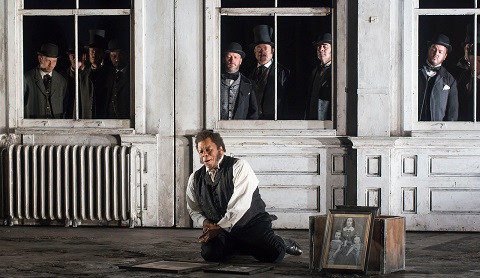 Lester Lynch (Enrico) and ENO Chorus. Photo credit: John Snelling.
Lester Lynch (Enrico) and ENO Chorus. Photo credit: John Snelling.
Alden has moved the action to the mid-nineteenth century, and designer Charles Edwards’ dilapidated mansion resembles a decaying boarding school worthy of the bleakest Victorian novel: dark, damp and decrepit, with Lucia the lone sleeper in the chilly dormitory at the start of Act 1. Indeed, the opening image brought Jane Eyre’s experiences at Lowood School to mind - Enrico would certainly give Mr Brocklehurst a run for his money in the cruelty stakes - and this wasn’t the only literary comparison that seemed pertinent during the performance. This Lucia is an ‘inmate’, imprisoned in a mental asylum, and the insane are her jailors. When Enrico ties her to her bed with a skipping rope in their Act 2 confrontation, I was put in mind of the “atrocious” former nursery at the top of the house, with its barred windows, nailed down bedstead, iron rings in the walls, and peeling wallpaper - “repellant, almost revolting; a smouldering, unclean yellow” - in which the narrator of Charlotte Perkins Gilman’s The Yellow Wallpaper finds herself similarly imprisoned by her oppressive husband.
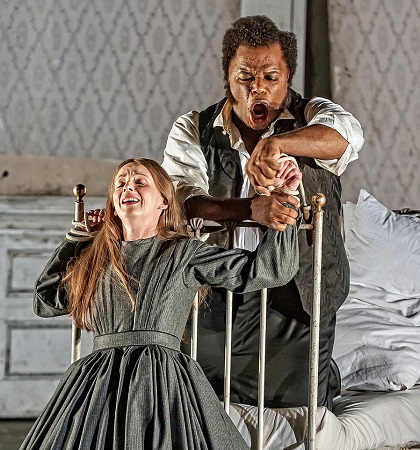 Lester Lynch (Enrico) and Sarah Tynan (Lucia). Photo credit: John Snelling.
Lester Lynch (Enrico) and Sarah Tynan (Lucia). Photo credit: John Snelling.
When Lucia, teetering on the edge of mental crisis from the first, succumbs absolutely to insanity, her mad display seems to provide the observing crowd with delectation and delight. Her bloody self-destruction doesn’t seem so much an ‘escape’ through a madness that evades the understanding and structures of her oppressors, but more a submission to an unavoidable destiny. Dressed like a doll, she resembles Carroll’s Alice - an image strengthened when Arturo arrives, posing elegantly in a pristine suit, and looking rather like the White Rabbit. But, her only comfort, a fluffy toy, is brutally torn apart by her brother; and, unlike Alice, Lucia will find no wonderland through Ravenswood’s looking-glasses or wardrobes - just fusty piles of ancestral documents. This child-woman has been assaulted by Enrico, manipulated by Raimondo, rejected by the deceived Edgardo, defiled by Arturo (one presumes); the last drop of her innocence is destroyed when she is forced to watch Edgardo’s demise.
Alden sustains the trope of the gaze which objectifies - Lucia is after all the ultimate commodity, her body the material means by which Enrico will pay off the family debts, her sacrifice designed to ensure the survival of the house and family name - through imagery of the theatre and performance. We first see Lucia seated at the foot of a curtained proscenium and, when the curtain is drawn back, her confrontations - romantic and deadly - will take place upon its stage. At the close, the theatre swivels and we are taken behind the scenes, unavoidably complicit in the gaze of the male chorus who sit in the on-stage audience ranks, alongside the dead Lucia, surrounded by the framed photographs which have now become gravestones.
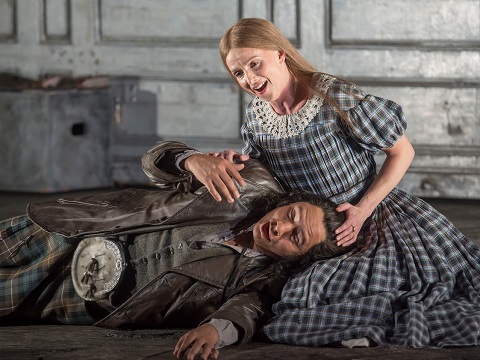 Eleazar Rodríguez (Edgardo) and Sarah Tynan (Lucia). Photo credit: John Snelling.
Eleazar Rodríguez (Edgardo) and Sarah Tynan (Lucia). Photo credit: John Snelling.
The ENO Chorus were in splendid voice, and Alden’s blocking (revival movement director, Maxine Braham) emphasised the rigidity of the social manacles which enchain Lucia. Lined up in dour grey, with sour scowls, their condemnatory weight was crushing. It was hard though to imagine such a joyless crowd engaging in revelry after the wedding of Lucia and Arturo, and, indeed, Alden and lighting designer Adam Silverman (revival lighting director, Andrew Cutbush) keep the party shrouded in shadows which means that Raimondo’s arrival with the news of Arturo’s death and Lucia’s demise doesn’t make such a strong dramatic impact as it would were the entertainments colourfully contrasted with the behind-scenes tragedy.
American tenor Lester Lynch was an imposing Enrico: self-righteous, solipsistic and frighteningly sadistic - a huge presence and a resounding voice, with clear diction. Lynch and Clive Bayley’s malicious, manipulative Raimondo were a deeply disturbing double-act, Bayley emphasising the cruelty of the pastor through his aggressive demeanour and thunderous delivery.
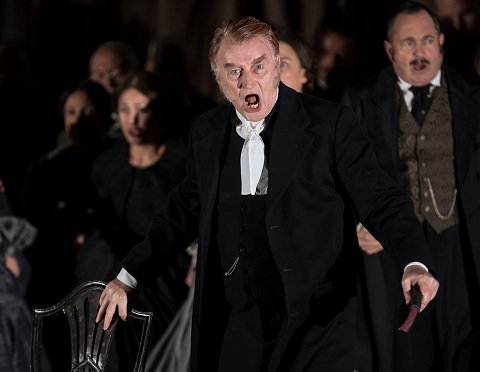 Clive Bayley (Raimondo). Photo credit: John Snelling.
Clive Bayley (Raimondo). Photo credit: John Snelling.
I found Eleazar Rodríguez’s heroic assaults on Edgardo’s soaring phrases in Act 1 a little too hefty, but he found a true bel canto flexibility subsequently, making a gleaming contribution to the Sextet, and convincingly conveying Edgardo’s anger and hurt in the face of Lucia’s supposed betrayal. Michael Colvin’s lighter tenor offered a pleasing contrast, and he displayed lovely colour and vocal grace as Arturo. The role was a better fit for Colvin than his recent essay as Herod in Adena Jacobs’ Salome and it felt a pity that Alden doesn’t foreground Arturo more. Alisa is also often pushed into the shadows, though Sarah Pring gave a fine performance, vocally and dramatically; to extend the Jane Eyre parallel, she reminded me of Grace Poole, a figure of mystery residing in the half-light and hinterland.
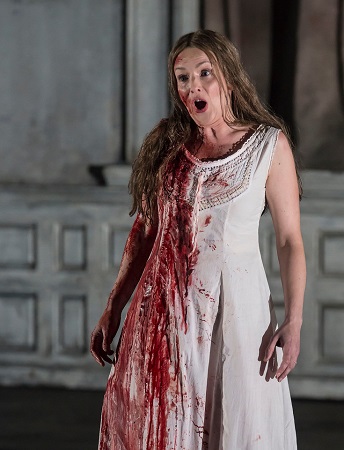 Sarah Tynan (Lucia). Photo credit: John Snelling.
Sarah Tynan (Lucia). Photo credit: John Snelling.
Sarah Tynan, making her role debut in the title role, was in a class of her own. Her light soprano conjured a delicate Lucia, fey and vulnerable; her voice stayed relaxed even as it climbed and her coloratura - she omitted the cadenza in the mad scene - was not decorative but truly expressive of Lucia’s battered and suffering soul - beautifully phrased, controlled, spacious, the dreamy wistfulness enhanced by the glass harmonica.
Conductor Stuart Stratford led a superb performance by the ENO Orchestra: stark swipes of instrumental colour never over-powered the singers, the pace was dramatic but not precipitous, the tension sustained.
Alden’s 2008 production , reprised once before in 2010 was ENO’s first staging of Lucia di Lammermoor. It was, and is, a terrific addition to the company’s repertoire, especially when in the hands of such a splendid team of singers and musicians.
Claire Seymour
Donizetti: Lucia di Lammermoor
Lucia - Sarah Tynan, Enrico - Lester Lynch, Edgardo - Eleazar Rodríguez, Arturo - Michael Colvin, Raimondo - Clive Bayley, Alisa - Sarah Pring, Normanno - Elgan Llŷr Thomas; Director - David Alden, Conductor - Stuart Stratford, Set designer - Charles Edwards, Costume designer - Brigitte Reiffenstuel, Lighting designer - Adam Silverman, Revival lighting designer - Andrew Cutbush, Movement director - Claire Glaskin, Revival movement director - Maxine Braham, Orchestra and Chorus of English National Opera.
English National Opera, London Coliseum; Thursday 25th October 2018.
image=http://www.operatoday.com/Lucia%20and%20Arturo%20.jpg image_description= product=yes product_title=Lucia di Lammermoor, ENO product_by=A review by Claire Seymour product_id= Above: Sarah Tynan (Lucia), Michael Colvin (Arturo)Photo credit: John Snelling
October 25, 2018
Verdi's Requiem at the ROH
Indeed, Verdi was a vociferous participant in the conflict between Church and State, and, at this stage of his life, was probably agnostic. The death of Alessandro Manzoni - the poet and novelist whom the composer venerated, and whose I promessi sposi (1827), a patriotic text which was a forerunner in the development of a unified Italian language, is customarily considered to be a symbol of the Italian risorgimento - prompted Verdi to return to and revise the ‘Libera me’ that he had composed for the planned Rossini commemoration. A letter which the composer penned to Clara Maffei on day of Manzoni’s funeral, declared: ‘Now it is all ended! And with him ends the purest, the most holy, the highest of our glories!’ David Rosen (in the Cambridge Music Handbook to the Requiem) remarks Verdi’s mixture of nostalgia and pessimism, and suggests that ‘in bidding farewell to Manzoni, Verdi was also writing a “Requiem for the Risorgimento” and marking a passing of a whole generation and a whole tradition’.
This performance at the Royal Opera House of Verdi’s Requiem fulfilled several functions, and these were also not without political inference and context. As conductor Antonio Pappano explained in his opening address, the performance celebrated the awarding of the Royal Charter fifty years ago to what was then known as the Theatre Royal, Covent Garden; and, as Armistice day approaches, it commemorated the end of WWI and remembered those who died in that conflict. Pappano also urged us to remember the recent passing of the soprano, Montserrat Caballé.
This performance was not a religious ritual though, but, it was one of emotive, spiritual, as well as dramatic, impact and import. The ROH stage was crowded, the House’s Orchestra raised from the pit and the Chorus assembled behind - and, perhaps, pushed a little too far from the four soloists arrayed at the front of the stage. Not all of the choral text was communicated clearly and directly, and the Chorus members took a little while to get into their stride: the basses’ opening ‘Te decet hymnus’ was a little cloudy - just as, later, the closing fugue was a little flabby. But, the ROH Chorus made their mark when it counted. A fortissimo ‘Rex tremendae majestatis’ from the basses was countered by a wonderfully graded quiet response from the divided tenors. The double choir opening of the Sanctus also seemed rather woolly, perhaps because the singers were set so far back on the stage, but the ladies were light and precise in the subsequent counterpoint, carried aloft by springy string pizzicatos and deliciously light staccato motoring quavers which later swelled into roaring chromatic arcs.
Pappano conjured both operatic intensity and contemplative intimacy; notably, this was a spaciousness interpretation which offered time for apt reflection, though I didn’t feel that Pappano fully sustained the dramatic tension throughout the 90 minutes: the Lacrymosa seemed ponderous, the entry of the choir and percussion here, rather weighty. But, there was much orchestral and soli playing to admire. The muted celli sighed, barely a whisper, at the start, intimating terror, expectation and drama. The first ‘Requiem aeternam’ strove to obey Verdi’s instruction - il più piano possible: there was a sense of restrained weeping, a reverential hush.
The wrath of the Dies Irae was a terrifying energy: one admired the accuracy of the strings’ tumbling somersaults, the thunderous portentousness of timpani and bass drum, the punches from the horns and brass that hit with a full, fat fist, as well as the lovely solos subsequently from the clarinet and bassoon. The tricky opening of the Offertorio, for celli and woodwind, combined rhetoric and intimacy.
At the front of the stage the spotlight shone on the four young soloists, most especially on Lise Davidsen - in between ROH Ring cycles - who was deputising for the indisposed Krassimira Stoyanova. But, whatever the soloists individual merits, there was a real sense of the quartet working and communicating together, collectively. The trio ‘Quaerans me, sedisti lassus’ in the Dies Irae was full of penitence and relief - ‘You have saved me, by enduring the cross’ - and the quartet, ‘Hostias et preces tibi’ at the close of the Offertorio had the delicacy of a madrigal with respect to the placement of the parlando text.
And, so, to Davidsen’s performance. One of my colleagues commented on her participation in the Requiem at this summer’s Proms , admiring the ‘accuracy of her singing, the brilliance of her upper register and the ability to scale her dynamics’, and judged her ‘Libera me’ to be ‘a tour de force: exquisite strength, imperious high notes and a pianissimo that was ravishing. This is a voice that doesn’t just cut through the orchestra like a sabre; it rises effortlessly above it as well.’ - sentiments with which I concur absolutely after this performance. There is such astonishing power and steel, on show and seemingly in reserve, that it takes one’s breath away. Thus, one marvels that Davidsen can float such effortless arcs of gleaming sound: her entry in the Kyrie seemed to lift the music from its roots - Pappano’s tempo was definitely on the un poco side of animando - like a magnet, brightening and elevating the ensemble sound. She used vibrato judiciously and varied the tone expressively: there was a lovely sincerity at the start of the Recordare, above the cello’s easy lilt, and a well-judged warming of the tone as the phrases broadened. In the Libera me one could palpably feel the heat of the flame as she flung ‘Dum veneris judicare saeculum per ignem’ (When You come to judge the world by fire) into the firmament; she was complemented by some splendid bassoon playing here, though the strings could have been even more fragile. The expansive breadth of Davidsen’s phrasing made the explosive interruption of the Dies irae reprise all the more theatrical; the return of ‘Requiem aeternam’ pierced like a moonbeam through the soft darkness of the low-pitched chorus - perpetual light might indeed shine on them and us. Verdi asks for a pppp dynamic for the high Bb, rather optimistically perhaps, but I did wonder about the appropriateness of Davidsen’s crescendo through the sustained summit.
American mezzo Jamie Barton was Davidsen’s equal with regard to sonic impact, and perhaps surpassed her in expressive nuance. Her entry in the Dies irae, ‘Liber scriptus proferetur’, was crystalline, and when repeated subsequently, stirring and powerful. Barton has an innate instinct for the drama that resides within the vocal phrase: ‘Judex ergo, cum sedebit’ floated aloft the resonant chordal brass before plummeting an octave, the sound delving into our hearts and souls. Her ‘Recordare Jesu pie’ was gentle and sincere; ‘Lacrymosa dies illa’ was poised against the sobbing throb of the strings. Davidsen and Barton intertwined sensuously in ‘Salve me’, though I’m not sure Verdi’s pianissimo was observed. And, the Agnus Dei was perfectly tuned and composed, though subsequently marred by some wayward and missing flute entries.
Frenchman Benjamin Bernheim offered a tender tenor in ‘Ingemisco, tanquam reus’ (I groan, like the sinner I am) conveying a sense of the frailty of man, and unfolded the narrative persuasively building to his plea, on a secure high B, ‘Statuens in parte dextra’ (Let me stand at your right hand). Hungarian bass Gábor Bretz made less theatrical or emotive impact. Despite the spooky, spiky lower strings accompaniment, his entry ‘Mors stupebit’ felt rather distant, and the emphatic statement in the Dies Irae, ‘Confutatis maledictis’, was surely not con forza? But elsewhere, Bretz displayed a lovely legato line, and real elegance and nobility - as in ‘Oro supplex et acclinis’ (Bowed down in supplication I beg You); and, in the Lacrymosa he offered a softness of tone against the crystalline sheen of Barton.
At the close, Pappano dared to hold the silence: a time for deep reflection.
This ROH’s performance of Verdi’s Requiem was broadcast live on BBC Radio.
Claire Seymour
Verdi: Requiem
Lise Davidsen (soprano), Jamie Barton (mezzo-soprano), Benjamin Bernheim (tenor), Gábor Bretz (bass), Antonio Pappano (conductor), Orchestra and Chorus of the Royal Opera House.
Royal Opera House, Covent Garden, London; Tuesday 23rd October 2018.
image=http://www.operatoday.com/Lise%20Davidsen.jpg image_description= product=yes product_title=Verdi: Requiem, Royal Opera House, 23rd October 2018 product_by=A review by Claire Seymour product_id= Above: Lise DavidsenPhoto credit: Florian Katolay
October 24, 2018
Wexford Festival 2018
Not a bad 10th birthday present for the House, which opened in 2008 and was designated Ireland’s National Opera House in 2014, and one which this year’s Festival confirmed is greatly deserved.
Opening night offered a double dose of verismo viciousness and violence: a compelling alternative to Cav & Pag. Born in 1864, Leoni studied alongside Puccini and Mascagni at the Milan Conservatoire under the supervision of Amilcare Ponchielli and Cesare Dominicetti. When he emigrated in London in 1892, aged 28, Londoners took the Milanese composer of operas, sacred works and ballads to their hearts. “Signor Leoni, although a foreigner, has … proved himself a better friend to the cause of English music than most people seem inclined to admit,” wrote ‘G.H.C.’ in the Observer on 7th November 1909, and his view seems to have been shared by many, if contemporary newspaper reports and letter pages are anything to go by.
Correspondents praised Leoni’s instigation of the foundation of the Queen’s Hall Choral Society, of which he became conductor, and admired his endeavours “to inspire his chorus with a genial, warm Southern enthusiasm […] the general effect produced is keen and musicianly in the best sense of the word”. After a performance of Leoni’s oratorio Golgotha at the Queen’s Hall in 1911 one enthusiast, James Bernard Fagan, expressed the somewhat florid opinion that “Mr Leoni has done for sacred music what Francis of Assisi did for Christianity, bidding us look for the spirit of God not in cold, gloomy, formless abstractions on remote unscalable heights, but down on the warm earth - in trees and in flowers and in running waters, in the birds and in the beasts, and in the hearts of men”.
There’s not much evidence of “the spirit of God” in L’oracolo ( The Oracle) which premiered at Covent Garden on 28th June 1905, conducted by André Messager and with Antonio Scotti playing the vicious and venal Cim-Fen. Set in an opium den in San Francisco’s Chinatown, Camille Zanoni’s libretto - based on a Chinese-American story, The Cat and the Cherub, by Chester Bailey Fernald - is swift and sensational. It crams villainy and viciousness, kidnapping and stabbing, strangulation and insanity into its sixty minutes. Its personnel include gamblers and fortune-tellers, drug addicts and reprobates, as well as chattering choruses of children and vendors. The action takes us through the seedy back-streets of 1900 Chinatown, down alley-ways which are choked by the San Francisco fog and the festering stench of the running drains, and teaming with caterwauling costermongers. The opium dens of ‘Hatchet Row’ are ruled by Cim-Fen, a merciless cut-throat who wields his knife with slickness and a smile.
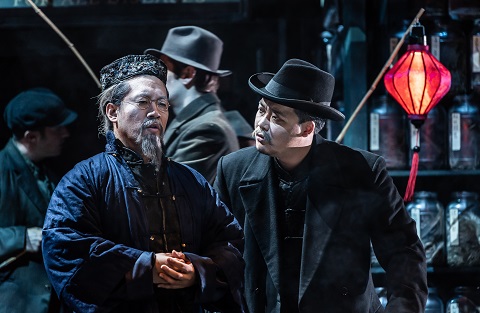 Leon Kim and Joo Won Kang. Photo Credit: Clive Barda.
Leon Kim and Joo Won Kang. Photo Credit: Clive Barda.
The eponymous Oracle predicts that two people will die, and murder follows murder with chilling speed and inevitability. When San-Lui discovers that Cim-Fen has kidnapped the child of the wealthy merchant Hu-Tsin - in a ploy to win the hand of Hu-Tsin’s niece, Ah-Joe, by heroically ‘rescuing’ the infant - Cim-Fen despatches his love rival with an efficient single hatchet-blow to the back of the head. Uin-San-Lui’s father, Uin-Scî, may be of philosophical bent, but that doesn’t stop him displaying his own thuggish resourcefulness and expertise in seeking vengeance. When the blade that he has plunged into Cim-Fen’s back fails in its fatal intent, Uin-Scî calmly winds his son’s killer’s plait around his neck and with delicate deliberation proceeds to strangle him. So peacefully occupied in quiet conversation do the pair appear, seated side-by-side on a bench, that a passing policemen notices nothing amiss.
Director Rodula Gaitanou and designer Cordelia Chisholm leave us in no doubt of the squalor and sadism of life in the ghetto. Dimly lit by Paul Hackenmueller, Chisholm’s set is dominated by a towering, three-story brick edifice which revolves to reveal the business premises of Dr Uin-Scî, a Chinese herbalist, the imposing entrance to the domestic quarters of Hu-Tsin, and the red-lit steps which descend into the bowels of Cim-Fen’s opium den. We are swirled along with the chattering Chinese inhabitants through the network of grimy alleyways. A corner street-light illuminates the coarseness and brutality of the gamblers, drug-takers and drinkers departing Cim-Fen’s den: knives flash in the lamp-light gloom, fists lash out, grievances are born and nurtured. Even the festive spectacle of a Chinese New Year Dragon Procession doesn’t alleviate the shabby sleaziness: the festooning red balloons can’t hide the shabbiness of the parading wagons, and the arching Dragon dips and dives menacingly, glaring with a mean, sharp-toothed stare.
Much of the success of L’oracolo was due to Scotti’s championing of the opera at the Met, where he persuaded General Manager Giulio Gatti-Casazza to present the work in 1915. It became a star vehicle for Scotti - often paired with Cavalleria Rusticana, Pagliacci, L’Amico Fritz and even La boh ème - until 1933, when the 55th performance of the opera served as the Italian baritone’s farewell to the house. Here, Joo Won Kang was entrusted with embodying the repugnant Cim-Fen, and his baritone was darkly aggressive at the bottom, richly coloured in the middle and firm of weight throughout. As Uin-San-Lui, Sergio Escobar provided complementary lightness and beauty, his tenor ringing brightly at the top, though there was little chemistry between Escobar and Elisabetta Farris’s Ah-Joe. But, if their voices didn’t blend with sufficiently powerful rhapsodic intimacy in the duet which is ended by Cim-Fen’s plunging knife, then the gentle beauty of Farris’s soprano did win our pity for the suffering girl, though Gaitanou did little to suggest that Ah-Joe’s grief was followed by mental derangement.
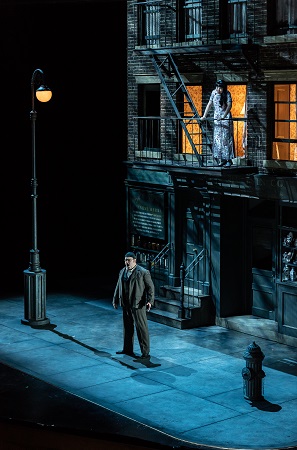 Sergio Escobar and Elisabetta Farris. Photo Credit: Clive Barda.
Sergio Escobar and Elisabetta Farris. Photo Credit: Clive Barda.
Leon Kim was superb as Uin-Scî, his grave and authoritative manner never concealing the sincerity of his love or integrity of his belief: the bereaved father’s appeal to the ‘Supreme Divinity of the Western Sky’ to reveal his son’s assassin was both chilling in its implications and compelling in its genuinely human motivation. The role of Hu-Tsin was commandingly sung by Benjamin Cho, while Louise Innes acted and sang convincingly as Hua-Quî, nurse to the kidnapped Hu-Cî. The latter was portrayed with infectious spiritedness by Cillian McCamley, who yawned cheekily during the adults’ rituals and sprinted around mischievously before he was imprisoned by Cim-Fen, first a garbage bin, then down the coal chute.
Conductor Francesco Cilluffo - who led Mascagni’s Isabeau impressively at Opera Holland Park this summer - had the measure of the score’s melodrama and pace, finding both stirring passion and moments of lightness, and the Orchestra of Wexford Festival Opera painted the diverse local colours with vividness and energy. There was especially fine playing from the lower strings, particularly during Uin-Scî’s retributive prayer and vow.
Despite the unalleviated ruthlessness and savagery which Leoni and Zanoni dish up, Gaitanou obviously felt there was room for more. Leon Kim’s Chinese herbalist did not consider throttling-by-pigtail to be sufficient punishment for his son’s murderer: instead, he exercised a ritual disembowelment of the barely-breathing Cim-Fen, slicing through clothes, peeling back skin and plunging his hand into the cut-throat criminal’s chest - should we have been in doubt, by the close the latter really was ‘heartless’. And, though the libretto ends with Uin-Scî’s vengeful actions undiscovered, here the clinical killer immediately confessed his crime to the passing policeman, crossing his wrists to indicate that the cuff-links should be clicked into place. The result was not the resumption of ‘normal’ life with which the original concludes, but the unbalancing of the scales of justice.
After the interval, Chisholm’s set was deftly transformed - out with the herbalist and in with Valentino’s cobbler’s shop, the Bella Napoli café replacing the opium den, and laden washing-lines adding to the authenticity of the milieu in the second Act - in order to transfer us from San Francisco’s Chinatown at the turn of the century to New York’s Little Italy in the 1950s. There are no knifings or strangulations in Umberto Giordano’s Mala vita but, like L’oracolo, for a relatively small-scale drama the large-scale musical climaxes pull no emotional punches and hit the theatrical bull’s-eye. Librettist Nicola Daspuro’s lurid tale of Neapolitan low-life - based on a play by Salvatore Di Giacomo and Goffredo Cognetti, which was itself derived from Giacomo’s 1888 short story Il voto (The vow) - was a success at its premiere in Rome’s Teatro Argentina in February 1892, and also surprisingly well-received when, translated into German, it was subsequently presented in Germany and Austria. But, Mala vita didn’t go down so well with the Neapolitans, who were less appreciative of Giordano’s ‘veristic’ - in their eyes, insulting - depiction of the ‘wretched lives’ endured in Naples’ ugly alleyways and slum dwellings.
The opera takes us into what Matilde Serao, the author of Il ventre di Napoli (1884), described as ‘the bowels of Naples’. Vito, who works in a dye-house, believes that the tuberculosis that afflicts him, rather than being an inevitable consequent of the chemicals and fumes he ingests each day, is a punishment from God for his misdemeanours - including his affair with Amalia, of which only her coachman husband Annetiello seems unaware. In hope of a cure and divine forgiveness, Vito vows to give up Amalia and marry a prostitute, thereby saving the fallen woman from a life of degradation and his own soul from damnation. News of his vow travels fast through the slum alleyways and when Cristina drops a rose from her brothel window onto the passing Vito’s shoulders, she is chosen as his path to redemption - to the brothel-regular Annetiello’s amusement and Amalia’s anger. The latter confronts Cristina, and Vito, unable to resist Amalia’s wiles and charms, ditches Cristina along with his plans for physical and moral improvement, leaving Cristina to lament that Jesus obviously didn’t want her to be redeemed after all.
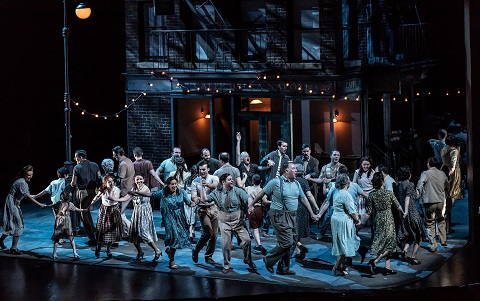 Chorus of Mala vita. Photo Credit: Clive Barda.
Chorus of Mala vita. Photo Credit: Clive Barda.
The expansive anguished and impassioned outbursts of the three protagonists stand out against the musical ‘backdrop’ provided by Giordano of everyday neighbourhood goings-on, and the Wexford Festival Chorus sang, and danced, with real spirit and vivacity. Gaitanou blocked the ensemble scenes more successfully than in L’oracolo, where occasionally the narrow street-strip at the front of the stage seemed crowded and the Dragon procession felt less than fluid. In contrast, the traditional Piedigrotta procession and festivities were vividly animated: the tarantella sprang ebulliently as the Neapolitan folk songs rang out colourfully, the snaking lines of revellers intertwined dexterously, and the children practised their dance-steps at the side of the stage. Similarly, the Chorus captured the intensity of the community’s belief in popular local superstitions during the opening vow scene.
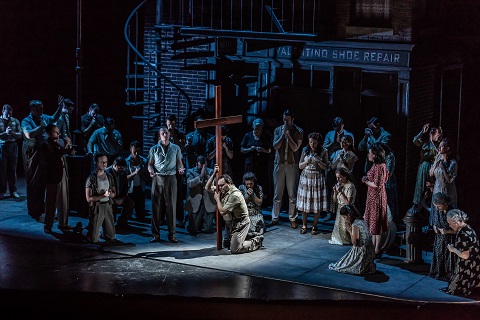 Sergio Escobar and Chorus. Photo Credit: Clive Barda.
Sergio Escobar and Chorus. Photo Credit: Clive Barda.
Escobar was able to tap all the warm lyricism of his tenor and did his best to make Vito’s lurches from fervent prayer to ardent romance convincing, as he switched from devout consumptive to devious charmer in the blink of an eye. The characterisation is largely conveyed through the three main duets which bring Vito and Cristina together in Act 1, Amalia and Cristina into confrontation in Act 2 and subsequently reunite Amalia and Vito, and Escobar was well-partnered by both Dorothea Spilger’s Amalia and Francesca Tiburzi’s Cristina. Spilger was a powerful presence especially in Act 2, which Amalia dominates, communicating all of Amalia’s selfishness, recklessness and wilfulness. Her mezzo-soprano is powerful and focused, and in the lunchtime recital which she gave the following day, in St Iberius’s Church, she revealed its full range of colour, vibrancy and intensity, the dense layers of the bottom being complemented by strikingly intense and pure top notes. Spilger moved effortlessly between high and low, too, and her presentation of songs by Brahms, Schumann and Richard Strauss, and an aria from Lehár’s Zigeunerliebe, confirmed her flawless technique and assurance, and dramatic range.
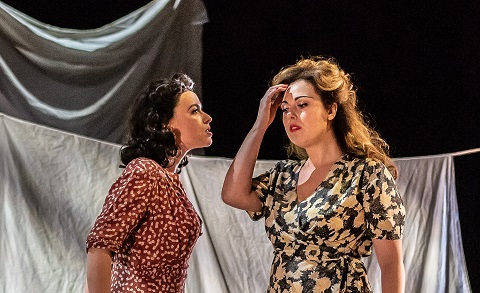 Dorothea Spilger and Francesca Tiburzi. Photo Credit: Clive Barda.
Dorothea Spilger and Francesca Tiburzi. Photo Credit: Clive Barda.
In Mala vita, however, it was Tiburzi’s Cristina who almost stole the show with her Act 3 prayer, in which the sensuous richness of her mezzo suggested, ironically, that her real passion and fervour was reserved for the spiritual rather than the earthly. Tiburzi had terrific rapport with Escobar’s Vito, and in their Act 1 duet the lucidity and elegance of line evoked the tenderness of a Puccinian melody. Annetiello is a rather limited role (when Giordano revised the opera and represented it as Il voto (The vow) in 1897, he omitted the character) though Leon Kim made the most of it, relaxing his baritone to suggest a good-time-lad preoccupied with the pleasures in life. He joyfully anticipated the hedonistic excesses of the festival to come, as he prepared his horses’ harnesses and plumes, and joined his mates in a rousing brindisi in Act 3. Benjamin Cho and Anna Jeffers provide good support in the roles of Marco and Nunzia respectively.
Cilluffo again conducted with conviction, driving the orchestra to emotive act closures and summoning a rich palette during the Intermezzo in Act 2 which provides some musical pathetic fallacy during the storm, while also creating moments of intimacy through some excellent quiet string passages.
Gaitanou once again exercised directorial license with the ending. In the libretto, as Cristina ends her prayer, the folk song which Annetiello has sung during the festivities is heard again, reminisced by the off-stage chorus, suggesting that while Cristina suffers alone the indifferent community continue their Piedigrotta revels. The sound of the song rouses Cristina who cries contemptuously, “Infami! Vili! Ah!”, before rushing back towards the door of the brothel. Gaitanou clearly can’t envisage Cristina resuming her former employment, so she has the prostitute put a gun to her head and pull the trigger. Giordano, like Leoni, takes the action back to where it started: no moral judgements are made, this is simply how these people live their lives. I would have preferred this ‘slice of life’ plain, without any aesthetic air-brushing.
Indeed, ‘endings’ proved rather problematic at Wexford this year! So composer William Bolcom and librettist Mark Campbell explained during their ‘Meet the Creators’ talk, the morning following the European premiere of Dinner at Eight, a co-production with Minnesota Opera where the opera was first seen in March 2017. Campbell’s libretto offers a very different ‘slice of life’. Based on George S. Kaufman and Edna Ferber’s 1932 play, Dinner at Eight is a black comedy which pillories and pities the desperate efforts of a bunch of nervy New York socialites to keep up appearances as the miseries of the Depression, and their own foibles and moral weaknesses, threaten to bring their paper-thin social edifices tumbling down.
During the week preceding Millicent Jordan’s eponymous dinner, the hostess frets about the fate of the gastronomic centrepiece as the lobster-in-aspic nose-dives to the kitchen floor; wails about the lone Hungarian viola player who replaces the planned string quartet; and hysterically laments the non-show of her prime exhibits, Lord and Lady Ferncliffe, who forgo her hospitality for the sunshine of Florida. Meanwhile, her guests struggle with rather more significant worries and reveal their instabilities, insecurities and immoralities. Oliver Jordan’s fragile grip on his shipping line company is being loosened by former actress Carlotta Vance’s need to sell her stock to avoid insolvency, and by the treacherous double-dealing of Dan Packard, a capitalist with political aspirations that his wife Kitty, who is having an affair with her doctor, Joseph Talbot, threatens to undermine. The Jordans’ daughter Paula wants to ditch her boring fiancé for the charms of former matinée idol Larry Renault, an aging has-been whose alcoholism has ravaged the good looks that were his only asset, and who has just been dropped from the cast of his latest Broadway play.
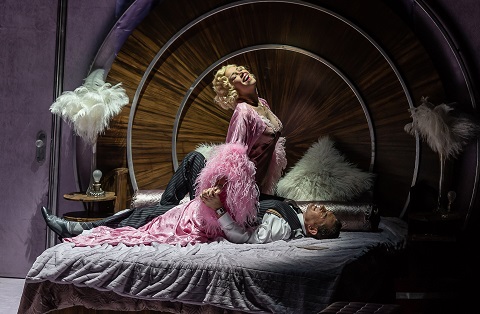 Susannah Billar and Brett Polegato. Photo Credit: Clive Barda.
Susannah Billar and Brett Polegato. Photo Credit: Clive Barda.
Set designer Alexander Dodge has supplied beautiful milieus for Tomer Zvulun’s production, and the sleek art deco elegance is charmingly complemented by Victoria Tzykun’s costumes and boldly lit by Robert Wierzel. The set is framed by a monochrome topographic jigsaw of Manhattan’s monuments - think Escher meets Google Satellite - and screened snippets of the Depression era nod towards the drama’s cinematic past (George Cukor’s 1933 film adaptation included John Barrymore, Jean Harlow, Marie Dressler, Lionel Barrymore and Lee Tracey, among others, in its ensemble cast). Time and place are well-defined: as Bolcom explained, the play was designed for a ‘local’ audience whereas the film had appealed to a broader set of ‘national’ viewers. The clean, cream splendour of the Jordans’ sparkling chandeliers and tortoise-shell inlays is juxtaposed with the tasteless trappings of the Packards’ gaudy, glitzy bedroom where Kitty reclines on the king-size bed, scoffing chocolates from a heart-shaped box and admiring her jewellery as she awaits the next dose of the doctor’s ‘medicine’. We see inside the clinical offices of Oliver Jordan and Dr Joseph Talbot, the walls sporting photographs of cruise liners and cross-sections of the human brain respectively, and witness Paula’s efforts to convince Larry to elope in the charmless hotel room from which the penniless thespian will shortly be evicted when the management’s patience runs out.
Bolcom’s score is a skilful medley of varied pastiches, played by a Broadway-tinted band that can swell with symphonic sumptuousness in-between-scenes, and withdraw to sensitively support the aria-numbers allotted to each of the struggling protagonists. There are some fine woodwind colourings, toe-tapping rhythms, and lush climaxes, but while slick, the score isn’t very memorable.
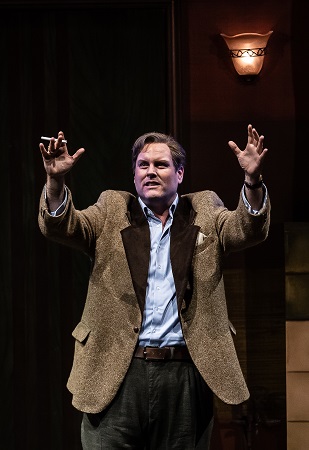 Richard Cox. Photo Credit: Clive Barda.
Richard Cox. Photo Credit: Clive Barda.
Several of the cast were reprising their roles from the original Minnesota Opera production. Stephen Powell’s warm baritone made Oliver Jordan’s vacillations between honest self-appraisal and the need to sustain Millicent’s delusions and desires real and engaging, and Oliver’s nostalgic duet with Brenda Harris’s larger-than-life but down-on-her-luck Carlotta Vance was one of the musical highlights. Craig Irvin boldly captured Dan Packard’s self-important, arrogant swagger. Susannah Biller’s gold-digging doll, Kitty, was a perfect picture of frothy, pink-swathed self-indulgence; it was hard to suppress a smile when Kitty’s maid, Tina, brightly sung by Laura Margaret Smith, resorted to subtle threats of blackmail to wheedle a diamante bracelet from her mistress. Sharon Carty impressed as Lucy Talbot, skewering her philandering husband’s weaknesses in a strong, purposeful aria of unflinching honesty, while Richard Cox conveyed all of Larry’s despair, frustration and anger in a powerful, bitter aria of failure and regret. Gemma Summerfield made much of Paula’s Act 1 lament about Larry’s wavering and her romantic woes. Presiding overall all with assurance, gloss and gleam was American soprano Mary Dunleavy’s Millicent - buoyant, resourceful, and, despite her histrionic excesses, resilient to the last.
Bolcom’s Sondheim-style idiom is easy on the ear, but the score does not itself have a ‘dramatic’ function. The following morning, Bolcom and Campbell described Dinner at Eight as musical theatre sung by opera singers: I’d go further and say that the music functions like a film score, colouring and joining the scenes but not itself explicating the characters’ motivations, actions and conflicts. Wexford’s Artistic Director David Agler, who conducted the opera in Minnesota and led a slick and neat performance here, has brought several American operas to Wexford during his very successful tenure. I very much admired Carlisle Floyd’s Susannah, which formed part of Agler’s first festival programme in 2005, as well as John Corigliano’s The Ghosts of Versailles (presented in 2009), and Samuel Barber’s Vanessa (in 2016); but, I was less enamoured by Peter Ash’s The Golden Ticket (in 2010) or by Kevin Puts’ Silent Night (in 2014). On this occasion, whatever my own misgivings, it’s fair to say that during the first performance of Dinner at Eight the Wexford clientele seemed absorbed and engaged.
And, so, what of the ‘ending’ that I mentioned above? A rhymed chorus gets the show underway, as the servants line up to inform us, with insouciant indifference to the impending tragedies, that “The party goes on, like it or not”. And, so it does: despite all the heartache and imminent doom, the gong sounds at eight o’clock and the guests take their places at the dinner table. Oliver’s luxury liners are about to sink as fast as his company’s share price, and he himself will succumb in three months to terminal heart disease, according to Dr Talbot’s grim diagnosis. Larry has committed suicide in his hotel room, by leaving the gas taps on, artfully arranging himself in a chair in one last theatrical pose. Marriages, careers and finances are floundering.
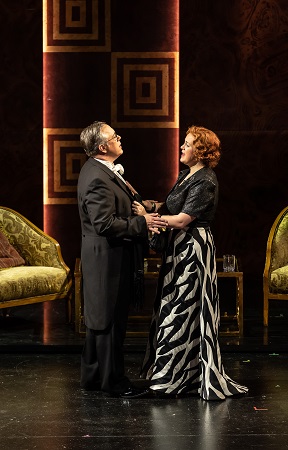 Stephen Powell and Gemma Summerfield. Photo Credit: Clive Barda.
Stephen Powell and Gemma Summerfield. Photo Credit: Clive Barda.
But, the Jordans vow that together they can survive both the evening’s trials and any downturns or upsets that the future brings. And, that’s that: curtain. It’s so inconclusive that the Wexford audience weren’t sure if the opera had actually finished. Act 1 builds towards Millicent’s spectacular hissy fit, and perhaps things should end there, as Act 2 has little further to add. Or, perhaps the opera needs an Act 3, so that we can find out what happens as the guests tuck into the spring lamb that the caterers have delivered to replace the ill-fated crustacean? Whatever, the current ending - which, we were told, the creators reworked when their original idea proved unsatisfactory - leaves us teetering on a cliff-edge then simply steps over the abyss and cheerily sweeps the brittleness aside. Are we to presume that the dinner party goes smoothly and with a swing, to the tuneful backdrop of a Hungarian czardas?
If there were unanswered questions at the close of Dinner at Eight , then the plot of Saverio Mercadante’s Il bravo (1839) proved unfathomable from the start, with the answers to some of the libretto’s mysteries supplied only in the closing scene. Fortunately, before these long-awaited revelations we had enjoyed three hours of terrific singing and playing; I felt veritably swept along on the crest of a grandiose musical wave of Verdian colour and energy.
Born in 1795, Mercadante was a significant figure in the world of nineteenth-century Italian opera. During a career which overlapped with Rossini, Bellini, Donizetti, and Verdi he composed sixty operas, and was for thirty years (1840-1870) the director of the Conservatoire in Naples. Wexford has previously shown faith in Mercadante, staging five of his operas: Elisa e Claudio (1988), Elena da Feltre (1997), Il giuramento (2002), La vestale (2004) and Virginia (2010).
Il bravo certainly confirmed the merits of Wexford’s conviction, though to say that the plot is confused, and confusing, is something of an understatement. Part of the problem is that too many pens have spoiled the plotting: Antonio Bindocci, Gaetano Rossi, Marco Marcelliano Marcello, and Felice Romani all worked on the libretto, which is based on the novel by James Fenimore Cooper by way of Auguste Anicet-Bourgeois’s playLa Venitienne. Set in sixteenth-century Venice, the action begins in media res and without knowledge of prior events and the historical background it’s virtually impossible to discern or make sense of the characters’ motivations and relationships.
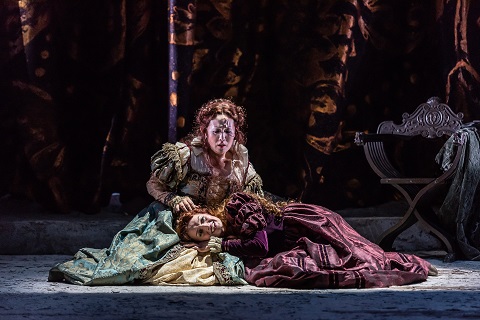 Yasko Sato and Ekaterina Bakanova. Photo Credit: Clive Barda.
Yasko Sato and Ekaterina Bakanova. Photo Credit: Clive Barda.
The characters assume multiple disguises and several names: Pisani, who loves Violetta, sports the Bravo’s mask and dagger for much of the opera; the Bravo himself dresses as a Dalmatian nobleman. The protagonists don’t even recognise each other: it’s only at the end that the Bravo (real name, Carlo Ansaldi), and Teodora (formerly known as Violetta) realise that they are in fact husband and wife - Carlo, who had stabbed Violetta when he suspected her of infidelity, had not killed her after all, and the younger Violetta, whom he had ‘adopted’ in order to protect her from the dastardly Foscari’s plans to abduct her, genuinely is his daughter. The drama is driven by the Bravo’s obligation to act as the Council of Ten’s assassin, in order that his father (jailed along with the Bravo for suspected treason) might be spared the death penalty: but, in the closing moments we learn that he has died in jail, so the pact, and its dreadful consequences proves to have been pointless.
The blue mists that swirled across the Wexford stage at the start of Renaud Doucet’s production certainly seemed - along with set designer André Barbe’s sharply angled perspectives of a Venice whose piazzas and waterways are glimpsed through the narrow openings of up-turned palaces - an apt metaphor for the plot’s obscurities. But, Doucet and Barbe muddy the canal waters still further by introducing a troupe of twenty-first-century tourists, trailing suitcases and taking selfies, who wander in anoraks and sneakers amid the patrician Venetians attired in gloriously elaborate sixteenth-century costume. Peering at maps and mobiles, they are apparently just as ‘lost’ as we are - and, I decided, best ignored.
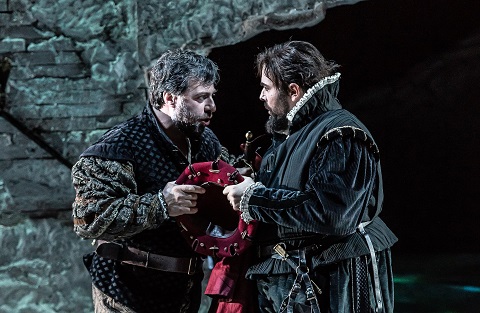 Rubens Pelizzari and Alessandro Luciano Photo Credit: Clive Barda.
Rubens Pelizzari and Alessandro Luciano Photo Credit: Clive Barda.
Indeed, it was easy to push the interlopers to the margins with such terrific singing to distract one’s attention. In the title role, Rubens Pelizzari gave a noble performance, attacking the lines cleanly with his robust tenor. This was a convincing dramatic performance: when, in Act 1, the Bravo returned to his home, divested himself of his mask and sang of his sadness, the murdering henchman seemed less like Sparafucile and more reminiscent of the tortured Rigoletto. In the second tenor role, Alessandro Luciano was less strong as Pisani but he climbed easily enough to the top and his phrasing was elegant.
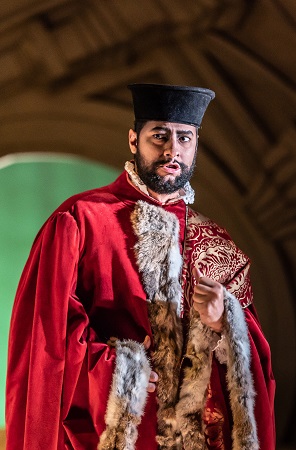 Gustavo Castillo. Photo Credit: Clive Barda.
Gustavo Castillo. Photo Credit: Clive Barda.
Baritone Gustavo Castillo was a fittingly menacing Foscari and agilely negotiated his cabaletta in Act 1. Yasko Sato seemed a little tentative at first, but her Teodora grew in stature and the Act 3 duet for mother and daughter was the expressive peak of the performance. Ekaterina Bakanova’s richly coloured soprano was just right for Violetta’s intensity and integrity. Conductor Jonathan Brandani whipped up musical storms and strife in the pit, drawing great energy from Mercadante’s striking harmonies and rich instrumental colours, but he also respected Mercadante’s more innovative and translucent orchestrations. All in all, the dramatic muddle was more than outweighed by the splendid musical drama.
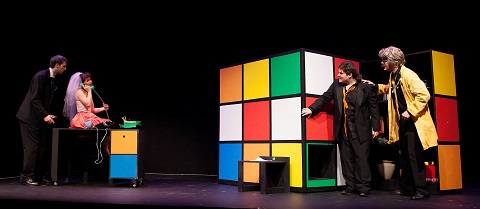 Cast of Don Pasquale. Photo Credit: Paula Malone Carty.
Cast of Don Pasquale. Photo Credit: Paula Malone Carty.
Alongside the three main productions, Wexford offered its customary three ‘Short Works’, performed at Clayton Whites Hotel, the first of which was an abbreviated production of Donizetti’s Don Pasquale staged by Kathleen Stakenas with music director Daniela Pellegrino. If Il bravo had shown just what a complex brain-teaser an opera libretto can be, then Stakenas and designer Angela Giulia Toso chose, literally, to house the Don in a Rubik Cube - an apt metaphor for the puzzles and problems posed for the aging Don by his duplicitous doctor, Malatesta, his nephew Ernesto, and the latter’s amour, Norina. One column of the Cube was withdrawn to reveal the Library where, after his ‘marriage’ to ‘Sofronia’, Pasquale would find his ‘wife’s’ pink pompons, pelicans and ponies perching next to his decanters and leather-bound tomes, as she squandered his fortune on fluffy frivolities. Pasquale never did manage to twist the clues into the right place and solve the riddle, but Stakenas told the tale clearly, though the necessary excisions weakened our appreciation of the schemers’ motivations - though, in any case, I always find their machinations rather too cruel given Pasquale’s ‘crimes’.
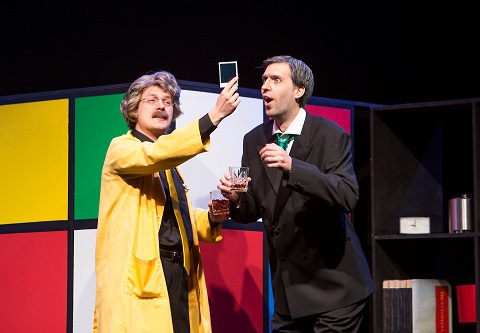 Simon Mechliński and Toni Nežić. Photo Credit: Paula Malone Carty.
Simon Mechliński and Toni Nežić. Photo Credit: Paula Malone Carty.
Toni Nežić’s Don Pasquale was morose and muddled, rather than pompous and furious, and in his oversize suit and shirt looked a portrait of misguidedness and misery. Although, despite a liberal sprinkling of hair-whitener, Nežić didn’t look old enough to be Ernesto’s uncle, the Croatian singer’s bass had a warm gravity and a persuasive maturity, and his performance was consistent and engaging. As Norina, Barbara Cole Walton displayed sheen and clarity at the top, and excellent intonation, but her soprano was not equally weighted throughout her range, becoming a little thin in the lower regions. She acted superbly though and, importantly, she resisted over-acting as she commandeered the telephone, doubled the butler’s salary, order to employ a hairdresser and jeweller to serve her needs, and announced to the dismayed and deluded Pasquale that, as he himself was too fat, old and decrepit, Ernesto would be her ‘cavalier’. Antonio Mandrillo was a sweet-toned Ernesto, but his tenor lacks real heft and he struggled a little with the dryness of the acoustic at Whites. Best of the cast was Polish baritone Simon Mechliński: a wily and witty Malatesta, he revealed a secure technique, a relaxed, agile baritone, and a comfortable stage presence, manipulating his patient with glee and ease. Nežić and Mechliński proved equally adept in their patter duet, while Mandrillo and Cole Walton blended well during their nocturnal rendezvous in the Don’s garden.
The following lunchtime, Bernstein à la carte proved less satisfying. Director Roberto Recchia is a regular at Wexford and his Short Work productions have offered much mirth and musical merit - including an ingenious L’elisir d’amore in 2013, La Cenerentola the following year, Donizetti's II Campanello in 2016, and Rigoletto last year.
This celebration of Bernstein’s ‘100th birthday’ fell a little flat though: not that the performances of the seven-strong ensemble were less than spirited and technically assured, rather that the situation - a party held for ‘Lenny’ in which each singer unwrapped their ‘present’, one of Bernstein’s scores, thereby prompting an aria or ensemble from the said work - felt somewhat contrived. Despite the complementary primary colours of the chaps’ sassy suits and lasses’ satin frocks, the milieu - white Ikea-cubes, champagne bottles and some bright balloons - was rather charmless, and the opening number, a medley which overlaid West Side Story’s duet, ‘Tonight’, sung powerfully by Gemma Summerfield and James Lui, and the Quintet and Chorus of the same name, didn’t sit very comfortably. The proceedings took a little while to get into their stride too, though Summerfield did sterling work establishing the context and holding things together. A screen at the rear showed images of Manhattan, film and score playbills, and helpfully provided a guide through the works performed - useful given that the roster included both the familiar and the rare.
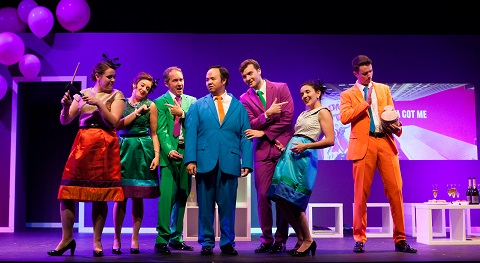 Cast of Bernstein à la carte. Photo Credit: Paula Malone Carty.
Cast of Bernstein à la carte. Photo Credit: Paula Malone Carty.
We were treated to numbers from Wonderful Town (including ‘What a waste’ and ‘) and On the Town. ‘I can cook too’ from the latter segued into La bonne cuisine, prompting a display of culinary ‘prowess’ from a team of chefs, who threw just about everything - including a length of old rope, a rubber chicken and a decapitated fluffy bunny - into the mix. Thankfully we were spared faux American accents, but some of the numbers felt in need of a bit more schmaltz and jauntiness: ‘I am easily assimilated’, from Candide would have been enhanced by a dash more rhythmic hyperbole, though the cooks’ wooden spoons served as admirable castanets; ‘Some other time’, from On the Town, felt a little underpowered.
Emma Nash gave a terrifically sparkling rendition of ‘Glitter and Be Gay’ though, and Summerfield’s ‘Somewhere’ was a highpoint - focused, poised and beautifully phrased. Owain Browne, who acted suavely and confidently throughout, turned On the Town’s ‘I Wish I Was Dead’ into a brilliant drag act and strummed a guitar tunefully to accompany Ranald McCusker’s reflective ‘It Must Be So’ (Candide). James Liu - cast here, a little awkwardly, as the party stooge - was less successful in ‘Maria’ where, unfortunately, the opening gambit - the tenor struggled to learn the song, freshly unwrapped from its box, to music director Tina Chang’s annoyance and frustration - subsequently seemed all too close to the bone as Liu’s improvisatory flights took him far from the home pitch. But, ‘Lonely Town’ (On the Town) was more satisfying, in which Liu was accompanied by the ensemble’s gentle humming.
Between the songs and ensembles we had readings from Bernstein’s letters, though not all of the cast were equally adept at projecting their spoken voices and I struggled to see the relevance of some of the readings to the surrounding musical material.
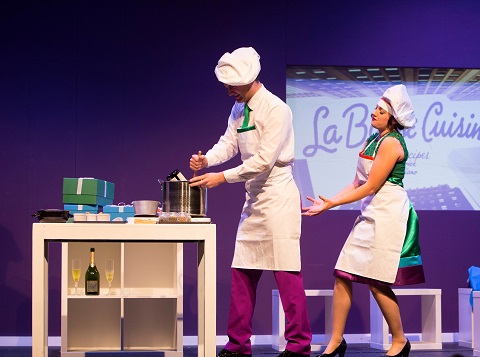 Ranald McCusker and Emma Nash. Photo Credit: Paula Malone Carty.
Ranald McCusker and Emma Nash. Photo Credit: Paula Malone Carty.
As we neared the close, I Hate Music!: A Cycle of Five Kid Songs offered some less frequently performed fare. After ‘The Wrong Note Rag’, in which Summerfield and soprano Rosemary Clifford demonstrated crystal-clear diction, we were, inevitably, urged to ‘Make Our Garden Grow’ ( Candide); the singing was impassioned and intense, though I wasn’t convinced that the a cappella episode was harmonically accurate.
Sadly, this year’s performance schedule meant that I had to miss the third of the Short Works, Puccini’s La fanciulla del West, but I did enjoy an unexpected musical bonus when Sir Thomas Allen took the opportunity to turn this year’s Dr Tom Walsh Lecture into a musical retrospective of his career, sharing and illustrating anecdotes of his early musical experiences: his father’s band playing; the encouragement of the Physics teacher who was eager to share the treasures of his LP collection with his young charge; the singer’s own early misconception that German songs were known as ‘lides’.
“Life has been one long serenade,” said Sir Thomas, after dulcetly crooning Don Giovanni’s ‘Deh vieni alla finestra’. One might say the same of Wexford. For those not able to attend this year’s Festival, the live streaming of Il bravo on Saturday 27th October at 8pm, offers an opportunity to share in the Festival spirit.
Claire Seymour
Giordano:
Mala vita
Vito - Sergio Escobar, Annetiello - Leon Kim, Cristina - Francesca Tiburzi,
Amalia - Dorothea Spilger, Marco - Benjamin Cho, Nunzia - Anna Jeffers
Leoni:
L’oracolo
Uin-Scî - Leon Kim, Cim-Fen - Joo Won Kang, Hu-Tsin - Benjamin Cho, San-Lui
- Sergio Escobar, Ah-Joe - Elisabetta Farris, Hua-Quî - Louise Innes, Hu-Cî
- Cillian McCamley
Director - Rodula Gaitanou, Conductor - Francesco Cilluffo, Set and Costume
Designer - Cordelia Chisholm, Lighting Designer - Paul Hackenmueller,
Orchestra and Chorus of Wexford Festival Opera
National Opera House, Wexford; Friday 19th October 2018.
Bolcom: Dinner at Eight
(European premiere)
Millicent Jordon - Mary Dunleavy, Oliver Jordon - Stephen Powell, Paula
Jordon - Gemma Summerfield, Carlotta Vance - Brenda Harris, Dan Packard -
Craig Irvin, Kitty Packard - Susannah Biller, Larry Renault - Richard Cox,
Lucy Talbot - Sharon Carty, Dr Joseph Talbot - Brett Polegato, Max Kane -
Ashley Mercer, Gustave - Sheldon Baxter, Miss Copeland - Maria Hughes, Tina
- Laura Margaret Smith, Miss Alden - Gabrielle Dundon, Eddie - Ranald
McCusker, Mr Hatfield - Henry Grant Kerswell, Zoltán - Feilimidh Nunan,
Supernumeraries - Alessandro Ambrosini, Elias Benito-Arranz, Chase Hopkins,
James Liu
Director - Tomer Zvulun, Conductor - David Agler, Set Designer - Alexander
Dodge, Costume Designer - Victoria Tzykun, Orchestra of Wexford Festival
Opera
National Opera House, Wexford; Saturday 20th October 2018.
Mercandante:
Il bravo
Il bravo - Rubens Pelizzari, Pisani - Alessandro Luciano, Foscari - Gustavo
Castillo, Luigi - Simon Mechliński, Teodora - Yasko Sato, Violetta -
Ekaterina Bakanova, Cappello -José de Eça, Marco - Toni Nežić, Un Messo -
Richard Shaffrey, Michelina - Ioana Constatin-Pipelea, Supernumeraries -
Susan Anderson, Sean Banfield, Martin Conway, Catherine Gaul, Colman
Hickey, Saran Moran, Sadhbh Murphy, Eoin O’Connor, Eoin Pinaqui, Alex
Saunders
Director - Renaud Doucet, Conductor - Jonathan Brandani, .Set & Costume
Designer - André Barbe, Lighting Designer - Paul Hackenmueller, Orchestra
and Chorus of Wexford Festival Opera
National Opera House, Wexford; Sunday 21st October 2018.
Donizetti:
Don Pasquale
Don Pasquale - Toni Nežić, Dr Malatesta - Simon Mechliński, Ernesto -
Antonio Mandrillo, Norina - Barbara Cole Watson, Carlino - Henry Grant
Kerswell
Music Director - Daniela Pellegrino, Stage Director - Kathleen Stakenas,
Stage & Costume Designer - Angela Giulia Toso, Lighting Designer -
Johann Fitzpatrick
Whites Clayton Hotel; Saturday 20th October 2018.
Gemma Summerfield (soprano), Emma Nash (soprano), Rosemary Clifford (mezzo-soprano), James Liu (tenor), Ranald McCusker (tenor), Jevan Mcauly (bass), Owain Browne (bass)
Music Director - Tina Chang, Stage Director - Roberto Recchia, Stage & Costume Designer - Angela Giulia Toso, Lighting Designer - Johann Fitzpatrick
Whites Clayton Hotel; Sunday 21st October 2018.
image=http://www.operatoday.com/Dinner%20at%20Eight.jpg image_description= product=yes product_title=Dinner at Eight, Wexford Festival Opera (European premiere, Saturday 20th October 2018) product_by=A review by Claire Seymour product_id= Above: Cast of Dinner at EightPhoto credit: Clive Barda
October 23, 2018
A New La bohème Opens Season at Lyric Opera of Chicago
The lovers who meet in Act One, Mimì and Rodolfo, are sung by Maria Agresta and Michael Fabiano. The second pair of lovers Musetta and Marcello, estranged until the close of Act Two, are portrayed by Danielle De Niese and Zachary Nelson. Additional members of the Bohemian group of friends are represented by Adrian Sàmpetrean as Colline and Riccardo José Rivera as Schaunard. The roles of Benoît and Alcindoro are performed by Jake Gardner. The Lyric Opera Orchestra is conducted by Domingo Hindoyan; the Lyric Opera Chorus is prepared by its Chorus Master Michael Black, and the Chicago Children’s Chorus is prepared by Josephine Lee. The production is directed by Richard Jones with sets and costumes by Stewart Laing and lighting by Mimi Jordan Sherin. Messrs. Fabiano, Rivera, Hindoyan, and Laing make their house debuts in these performances.
From the start of Act One the pacing among the group of male voices is lively and filled with the urge to make the most of the circumstances under which they live. Mr. Nelson’s rich, focused baritone is an ideal voice for the painter Marcello. His vocal projection, stylish delivery, and facial expressions underline a total identification with the character portrayed. Nelson’s banter with the writer Rodolfo about the attractions of Paris despite their frigid interior is delivered with lyrical gusto. In the role of the poet Rodolfo Mr. Fabiano sings with a truly Italianate warmth and a comfortable sense for legato. His top pitches with forte emphasis are used, at times, to delineate the volatile personality of the poet. Messrs Sâmpetrean and Rivera add to the bounce and color of the quartet, which performs this act against a stark white and black backdrop representing the garret. Once they have dispensed with the landlord Benoit, the group determines to continue their spirited mood in the Parisian outdoors. Rodolfo agrees to join their revelry after further attempts at writing, yet Mimì’s interruption at the door stage rear proves to be a fateful distraction.
Ms. Agresta is a marvel of touching ardor and lyrical expressivity. Both principal singers have become sufficiently identified with their roles, so that they succeed in giving a fresh, credible interpretation to this work. Fabiano sings with a continuous line of impassioned declaration, his voice rising and falling in keeping with the import of Puccini’s music. Agresta matches this sense of character portrayal by imparting a tentative shyness to initial lines, a technique which renders her ultimate participation in the duet more joyous. Both singers use piano shading to enhance their portrayals and to underscore the lovers’ growing commitment. By the close of the act thy have transformed the spare stage with their hope in new love.
Acts Two and Three are appropriate scenic opposites in this production. The ebullient and overpopulated stage of the Café Momus in Act Two extends the burgeoning passion with which the previous act had concluded. Arcades and outdoor passage-ways suggest the bustle of Parisian streets. Costumes are now more in keeping with an 1830s milieu. The bustle of figures at the tables stage-front allows the new lovers to blend in to the public society while at once sharing their intimate thoughts. This atmosphere also allows for the reconciliation between Marcello and Musetta, the latter arriving with her current companion. In the role of Musetta Ms. De Niese is brash and determined. She sings her waltz, perched on a café table, with a languid tone, inserting occasional pitches sharp to emphasize her growing emotional state. Her final gesture used to recapture the devotion of Marcello succeeds and seems fully at odds with the delicate innocence that has been traced for the first pair of overs. A more closely etched emotional identification informs the atmosphere of Act Three. Nelson’s importunate exchange with Mimi upon her return to see Rodolfo suggests his own emotional commitment now as well as his concern for Rodolfo. Once they are reunited Agresta and Fabiano sing of past, present, and future in ethereal shades of sadness, denial, and potential reconciliation. This duet remains, as it should, one of the production’s highlights, since the tone established enhances the poignancy of the final act.
In Act Four, now a mirror of the opening scene, all the principals focus on the deteriorating health of Mimì. The dedication of Musetta is admirably sung with graceful line by De Niese while Fabbiano’s Rodolfo seems to stave off the reality of illness until the final moments. Agresta’s voice rises with the self-denial of a final burst of strength, and wafts into the angelic repose of her final moments. Her performance captures the essence of the complex figure of” La bohème.”
Salvatore Calomino
image=http://www.operatoday.com/Michael%20Fabiano_Maria%20Agresta_LA%20BOHEME_LYR181003_141_c.Todd%20Rosenberg.JPG
image_description=Michael Fabiano and Maria Agresta [Photo © Todd Rosenberg]
product=yes
product_title=A New La bohème Opens Season at Lyric Opera of Chicago
product_by=A review by Salvatore Calomino
product_id=Above: Michael Fabiano and Maria Agresta [Photo © Todd Rosenberg]
Leos Janacek: Missa Glagolitica
Bělohlávek was the kind of conductor who always found fresh insights into what he did, no matter how familiar he was with the repertoire, so this set forms part of a series which commemorates the golden years of Bělohlávek's tenure with the Czech Philharmonic, which revitalized the orchestra as the foremost in its field. Recent releases have included Smetana's Má vlast, perhaps the most powerful expression of Czech identity in music. (Please read my review here), and a monumental Dvořák Stabat Mater. (Please read my review here).
Janáček's Glagolitic Mass (Mša glagolskaja) is heard here in the “September 1927” version edited by Jiří Zahrádka in 2011. It does not of course supersede the final, standard version of the piece. All editions involve informed guesswork, right or wrong. Controversies can be valid : witness the on-going dispute about movement order in Mahler's Sixth Symphony. Whatever the merits of rival editions, the September 1927 approach is distinctive and has its own merits beyond just demonstrating the composer’s working processes. The first edition of this version, by Paul Wingfield in 2008, revealed the raw potential behind Janáček's earliest ideas, and received enough performances to convince of its merits on its own terms. Thus it cannot be dismissed as mere curiosity, which is why Bärenreiter publishes it in two separate formats. The first recording of the 2011 Zahrádka edition was made in September 2013 by Tomáš Netopil and the Prague Radio Symphony Orchestra, just pipping this performance made in October 2013 by Bělohlávek and the Czech Philharmonic, which is more assured in every respect.
Some time before Janáček wrote the work, the Papacy had made special dispensation for Mass to be said in Slavonic instead of in Latin as was the norm then. This was hugely symbolic since it gave legitimacy to Slavic independence at a crucial point in time. The Glagolitic Mass commemorates the ancient roots of Slavic culture, just as the Sinfonietta celebrates the birth of the modern Czech nation. The Glagolitic script dates from the 8th century, long before the Hapsburgs consolidated their grip on Bohemia. This Credo isn't about the "Catholic and Apostolic Church" so much as Janáček's faith in secular and national Resurrection. Moreover, "Glagolitic" masses were held in the open air, with trees instead of stone as buttresses, allowing large communities to come together in Nature and sing. Of this piece, Janácek said: "My cathedral " was “the enormous grandeur of mountains beyond which stretched the open sky…...the scent of moist forests my incense”. Hence the idea of freedom and liberation, which is closer to Janácek's intentions than to a religious interpretation. This version of the Glagolitic Mass is craggier, more dissonant and more abrasive, but may reflect the rough-hewn spirit of the early church, and its possibly pagan antecedents, which is relevant since Janáček, an atheist, chose to set a language that had disappeared for hundreds of years.
Bělohlávek's approach is spirited but unsentimental, given the political background to Czech independence not only in Janáček's time but in the decades after his death. Freedom can't be taken for granted. Bělohlávek and his orchestra lovingly shape the "Janáček:" signatures, star motifs and quirky whips of melody that leap out provocatively against dense, angular blocks of sound. The theme "Gospodi pomiluj gospodi pomiluj" rises first in the orchestra, then in the chorus. Extremely precise singing from the Prague Philharmonic Choir and the soloists Hibla Gerzmava, Veronika Hajnová, Stuart Neill, and Jan Martiník, well experienced regulars in this repertoire, and in this piece in particular. The organ (Aleš Bárta) enters gradually, almost quietly, so whern it bursts forth in the Allegro, it feels wildly explosive, inspiring the orchestra and the chorus. The Credo (Vĕruju) bursts as if a mighty force has been biding its time. Exquisite beautiful moments like the violins in the Sanctus (Svet) before exuberant rhythms return, rushing ever forwards. This performance was recorded live at the Rudolfinium, hence the intense immediacy.
This Sinfonietta is based on the critical edition made by Jiří Zahrádka of the 1927 revision made by the composer, in an arrangement for reduced forces by Heinz Stolba. Given that Bělohlávek made this in February 2017, it is probably a first recording. To quote the publishers, Universal Edition Wien,"the motivation was to prepare a new reduced version to retain the festive effect of the fanfares at the beginning and end of the work, despite avoiding a separately positioned, additional group of brass instruments as prescribed in the original. In contrast to earlier reduced versions, in the present version all passages that were intended for the separate group of brass instruments in the original version are also entirely played by brass instruments. While a total of 25 brass instruments were required to perform the original version, in the present reduced version there are only 12. Moreover, two additional woodwinds were also cut down on, reducing the original number of wind instruments from 37 to 22, without significantly impacting the sonic result". It is shinier and leaner, and would make a dramatic statement in smaller concert halls and on informal occasions. Perhaps it's pertinent to note that 2018 marks the centenary of the founding of the Czech Republic. Though the piece was initially written to celebrate Czechoslovakia's military, it is as much about freedom and free spirits as about the military. If the Andante depicting the Castle at Brno does not loom as magnificently as in the original, there are compensations. The piccolo and flutes are effervescent, and the brass sounds cheerful. The open-air freshness works well in the Allegretto : imagine the people in the streets celebrating, waving flags and being happy.
An atmospheric account of Taras Bulba brings out the composer's Russian soul, but the loom is enlivened by characteristic Janácek feistiness - spiky staccato passages, and expansive open-ness which seems to connect the Prophecy of Taras Bulba to the strange visions of Mr. Brouček. More connections to Svatopluk Čech with The Fiddler's Child, a modern (at the time) retelling of a folk legend.
Anne Ozorio
image=http://www.operatoday.com/Glagolitic_Mass_Belohlavek.jpg
image_description=
product=yes
product_title=Leos Janacek: Missa Glagolitica
product_by=Hibla Gerzmava, Veronika Hajnova, Stuart Neill, Jan Martiník, Prague Philharmonic Choir, Czech Philharmonic Orchestra, Jiri Belohlavek
product_id=Decca 4834080 [2CDs]
price=$13.79
product_url=https://amzn.to/2R9ij4C
October 18, 2018
Arabella in San Francisco
Austrian dramatist Hugo Von Hofmannsthal, Arabella’s librettist, was nothing if not worldly and post WWI Vienna was nothing if not indulgent. This made rich ground for Richard Strauss to plow, playing seriously with Romantic ideals of love while toying with the poetic pastoralism of the Germanic Hellenistic revival, and indulging in the modernist zeal for dissecting reality.
It all became quite a celebration last night on the War Memorial stage at the first performance (of five) of this rarely performed example of the Strauss canon. The revelry was in the pit, the mighty San Francisco Opera orchestra unleashed by conductor German conductor Marc Albrecht in his American debut. Undaunted with only 67 players in the pit, a far cry from Elektra’s 100 or so, the maestro drove the score as if it had the richness and the urgency of Elektra’s obsession. The spectrum of colors, the motivic details, the phrasings and the volumes (considerable) that the maestro exploited did indeed verify masterpiece status if not outright awe for the score. They also made me long for singers and production that might equal such musical monumentality.
The well-traveled production (Toronto, Santa Fe, Minneapolis) by British director Tim Albery instead traded on the minimal. The sets and costumes by German designer Tobias Hoheisel were of utmost simplicity, a series of small, monochromatic, curving architectural elements of subdued classical detail construed the three spaces of von Hofmannsthal’s fin de siècle hotel. Von Hofmannsthal respects the Aristotelian unities — the opera happens before, during, and after a ball in the hotel — thus Mr. Hoheisel’s costuming has limited requirements, easily incorporating abstractions of fin de siècle opulence.
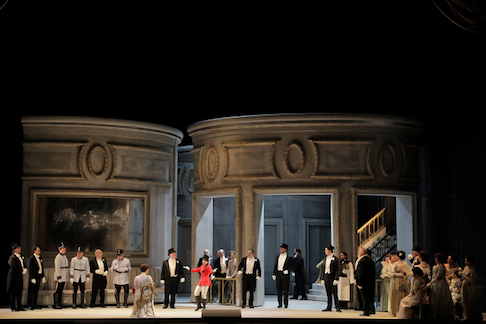 Hye Jung Lee (in red) as the ball mascot Fiakermilli
Hye Jung Lee (in red) as the ball mascot Fiakermilli
Director Albery moved his actors minimally, just enough to fulfill the musical and textural needs of the score. Every gesture was carefully measured to be an elegant surface motion that masked the musical compulsions underneath. It was smooth, indeed exquisite staging effected by a willing cast.
Like all Strauss female roles, Arabella too is vocally daunting. Most difficult are the moments of sublime beauty when the soprano floats an above the staff phrase over and beyond its apex, as had Strauss’ Marschallin. Then there are extended passages of longing, regret, reconciliation and finally ecstasy that sail through and above rich and soaring orchestral outpourings. Above all Strauss’ Arabella must be a beautiful woman who projects honesty and simplicity and compassion, and forgiveness for those who betray her. San Francisco Opera house soprano Ellie Dehn confronted the challenges of the role and largely succeeded, often rising to the monumentality imposed by the maestro.
Though Strauss loves most of all to exploit the female voice, in Arabella he challenges the endurance and the emotional spectrum of the baritone voice. Mandryka who has chosen Arabella to be his wife, made a bloodstained photo of Arabella his talisman for recovery after he was mauled by a bear. San Francisco Opera house baritone Brian Mulligan did not survive his first act explanation of all this, victim of the maestro who demanded a more experienced Strauss voice and more imposing presence to musically fulfill the Straussian ideal. Mr. Mulligan does possess a quite beautiful voice whose limits however were clearly exposed.
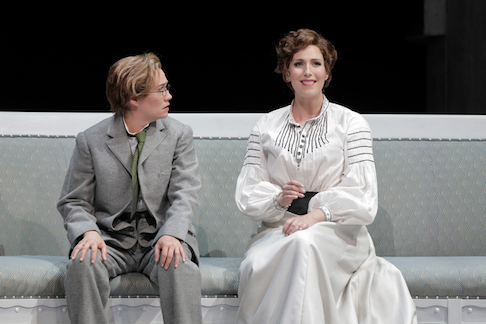 Heidi Stober as Zdenko, Ellie Dehn as Arabella
Heidi Stober as Zdenko, Ellie Dehn as Arabella
Von Hofmannstahl twisted the swain from pastoral poetry into a cross dressed soprano, here San Francisco Opera house soubrette Heidi Stober who gave a quite effective account of Zdenka who loves Arabella’s rejected suitor Matteo, however Zdenka is first known as the boy Zdenko who is Matteo’s best friend (you had to be there). Mme. Stober’s charming trouser role presence abetted by fine singing well matched the maestro’s need for a big house, tongue-in-cheek shepherd/ess. The Matteo of Swedish tenor Daniel Johansson held his own in the melee. Though missing the warm vocal colors to create the ideal Straussian swain he did project appealing musical energy.
Well cast as the Countess Waldner, mezzo soprano Michaela Martens made Arabella’s mother quite sympathetic in her enthusiastic support of the ruinous gambling addiction of her husband, Count Waldner sung by Richard Paul Fink.
The balance of the cast — three more suitors, plus the Fiakermilli — conformed to the in-house casting policy for this Arabella. The suitors were drawn from the Adlers (San Francisco Opera’s operatic finishing school) or equivalent. The Fiakermilli, usually a cameo role taken by an accomplished Ariadne Zerbinetta, was sung by former Merola participant Hye Jung Lee.
Michael Milenski
Cast and production information:
Arabella: Ellie Dehn; Zdenka: Heidi Stober; Countess Waldner: Michaela Martens; Fiakermilli: Hye Jung Lee; A fortune teller: Jill Grove; Mandryka: Brian Mulligan; Matteo: Daniel Johansson; Count Waldner: Richard Paul Fink; Count elemer: Scott Quinn; Count Dominik: Andrew Manea; Count Lamoral: Christian Pursell. Chorus and Orchestra of the San Francisco Opera. Conductor: Marc Albrect; Stage director: Tim Albery; Production designer: Tobias Hoheisel; Lighting Designer: David Finn. War Memorial Opera House, San Francisco, October 16, 2018
image=http://www.operatoday.com/Arabella_SF1.png
product=yes
product_title=Arabella at San Francisco Opera
product_by=A review by Michael Milenski
product_id=Above: Brian Mulligan as Mandryka [All photos by Cory Weaver, courtesy of San Francisco Opera]
October 17, 2018
Two falls out of three for Britten in Seattle Screw
That was the state of play as act one of Seattle Opera’s new-ish staging of The Turn of the Screw ended. As we drifted out into the watery-sun-filled lobby of Marion McCaw Hall, I’m sure many old-timers like me (and there a lot of old-timers at Saturday matinées here) were pondering the same paradox as I: How could the dazzling local 1994 première staging of this work – Lauren Flanagan, Joyce Castle, Cyndia Sieden, Mark Lamos, John Conklin, Robert Wierzel, all at the top of their form, Richard Bradshaw in the pit – remain so much more vivid in memory 24 years later than what we’d just experienced minutes before?
When we returned to our seats – some didn’t – we were quickly reawakened. In the first act the performers had hardly been able to move beyond sparse bright-lit patches without being swallowed by the shadows of Adam Larsen’s dim, grim projections of ravaged trees and shrubbery, of architecture more penal than domestic, more Piranesi than Palladio.
In act two, Peter Kazaras’s blocking allowed them to escape, make contact. For both them and the watcher it was like being allowed for the first time to breathe freely, to feel how Britten’s extraordinarily pictorial score shivers up from the pit, hot and cold, caressing and creepy at the same time. German-born conductor Constantin Trinks may have been trying to energize the first act as well, but if so not much was getting through. In any case it was enough to keep the musical tension growing right up to the final, creepy end.
That said, it was not a staging that made the most of its resources. The costuming, by Deborah Trout, was peculiar enough to be distracting. At first the clothes seemed to suggest a post-WWII Britain. As the Governess, soprano Elizabeth Caballero spent almost the whole show in a salmon-colored twinset (no pearls) and a garish green and white lino-print skirt. Along with her stiffly-permed processed-blonde hair, the outfit made her look a great deal more like a baby-sitter than a tutor and role model.
The dithering housekeeper, Mrs. Grose, by contrast, was given rather sumptuous gowns to wear, turning the social positions of the two ladies completely upside down and rendering her occasional lapses into submissive and servant-y language inconsistent and jarring.
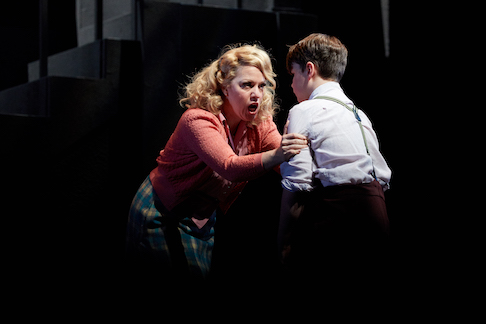 Elizabeth Caballero (The Governess) and Rafi Bellamy Plaice (Miles)
Elizabeth Caballero (The Governess) and Rafi Bellamy Plaice (Miles)
The oddity never really went away. The phantasm of the amoral footman Peter Quint looked like a hybrid of Mr. Rochester and Lady Chatterley’s lover, until turning up dressed like a Regency buck. His ghostly victim-accomplice Miss Jessel started off looking like a Renaissance portrait of a lady but rapidly descended into raddled dishevelment.
Henry James’s 1898 novella is set in a world that travels by carriage and communicates by letters by hand. Tweaks that take it out of that world just render it implausible, and a ghost story has to be plausible to work at all.
Director Kazaras does manage in the second act to get some dramatic oomph out of Larsen’s looming projections. Aided by Connie Yun’s lighting design, he turns the house of Bly itself into the threat, and the ghosts into just as much victims of its malice as the living inhabitants.
For whatever reason, though, he has not managed to allow his singers to make much of a mark. Even at his most diabolically inspired, creating ever-evolving loops and whorls of seductive menace, Britten makes dazzling waves, but the singers only ride the frisson like surfers, never able to command it.
Roger Downey
Cast and production information:
The Governess: Elizabeth Caballero; Mrs Grose: Maria Zifchak; The Gentleman/Peter Quint: Ben Bliss; Miss Jessel: Marcy Stonikas; Miles: Forrest Wu (October 14 performance). Flora: Soraya Mafi. Stage director: Peter Kazaras; Set: Robert A Dahlstrom; Projections: Adam Larsen; Lighting: Connie Yun: Costumes: Deborah Trout. Principal players of the Seattle Symphony Orchestra; Conductor Constantin Trinks. Performance of October 14, 2018.
image=http://www.operatoday.com/2018_JFL_TurnOfTheScrew_132.jpg image_description=Soraya Mafi (Flora) and Marcy Stonikas (Miss Jessel) [Photo by Philip Newton] product=yes product_title=Two falls out of three for Britten in Seattle Screw product_by=A review by Roger Downey product_id=Above: Soraya Mafi (Flora) and Marcy Stonikas (Miss Jessel)Photos by Philip Newton
New Hans Zender Schubert Winterreise - Julian Prégardien
I first heard Zender's Schubert Winterreise in 1994, conducted by Zender himself, with Ensemble Modern and Hans-Peter Blochwitz and didn't get it at the time. How things have changed ! That first recording is good, but this new one in many ways is better, since the work is familiar enough now that performers dare take chances and venture, like the protagonist in the cycle himself. By no means is it Schubert's own Winterreise but "eine komponierte Interpretation", a composed interpretation. A new work, not simply an orchestration of the cycle for piano and voice. There's absolutely no way it's an alternative to the original, but rather a meditation by a modern composer reflecting on his response to the most iconic song cycle of all.
Over the years there have been many performances of Zender's Schubert Winterreise, including Ian Bostridge's Dark Mirror, replacing the rather corny march round the hall of the original with an infinitely more sophisticated staging by Netia Jones. (Please read more here). Alas, that production wasn't preserved for commercial release, but we can settle for this audio-only version, since Prégardien's singing is so vivid that the music seems to come alive. This matters, for Winterreise is uncommonly visual music, evolving in stages each matched with images from Nature. Years ago, at a Wolfgang Holzmair masterclass, Holzmair told us to listen, like an animal might, sensing which trail to follow. This is no passive, meandering journey. but purposeful, the protagonist alert to the slightest clues in his surroundings, reading the air, the way a wild animal navigates its territory. Thus the long introduction in Zender : muffled sounds in the orchestra like footsteps trudging through deep snow. You can't quite hear unless you're listening properly.
In Zender's Schubert Winterreise the psychic dislocation of the piece is even stronger, allowing an almost Expressionist approach : this is not standard Lieder by any means and cannot be judged in pure Schubertian terms. Thus the spiky whirlwind in Die Wetterfahne, the strings blowing up a storm, so the singer's lines expand as if billowed by the wind. Prégardien's voice takes on an edge, very different from his normal plangent tones, which is perfectly appropriate in the circumstances. In Gefrorne Tränen, he shapes the first strophe tenderly, in contrast to the ferocity of the words "Ei Tränen mein Tränen". Similarly "die Blumen" in Erstarrung bloom, briefly before the chill sets in with a hard "gestorben". Der Lindenbaum begins with beautifully archaic sounds - plucked low strings and guitar - an idea further developed in Wasserflut by the horn (evoking hunting horn) and hushed Sprechstimme passages. In Rückblick, the saxophone's dissonance moves to sensuous allure, interrupted by trombones and bassoons. No "looking backwards" here. Thus the shimmering tenderness in Irrlicht and Rast seems haunted, and icicles spike Frühlingstraum. Prégardien alternates lyrical song with hard spoken prose.
A posthorn rings in Die Post, as if heard from a distance, perhaps in a nightmare, with rumbling percussion, creating striking contrast with the vocal line which stretches and soars - like a posthorn. Very eerie, but perceptive, since in Die Krähe, a crow circles round the protagonist, who will eventually follow the Leiermann into the unknown. In Wilhelm Müller's verse, there are many similar parallel pairings, such as the dogs and rattling chains in Im Dorfe, which appear again in Die Leiermann , which Zender brings out in his orchestration. Warlike violence in Der stürmische Morgen where turbulent percussion alternates with delicate pizzicato, segueing into a waltz like Täuschung. Echoes of church organ and funereal drums remind us that Das Wirtshaus marks the end for most mortals, but even here the protagonist cannot rest. Crackling sounds, winds, drums and pipes in Mut develop the warrior imagery heard earlier, for this courage is misleading.
Thus the desolation of Die Nebensonnen. Yet again, Zender integrates the songs so they complement each other. The quasi-hymn of Das Wirthaus flashes past before a surreal but striking introduction to the critical last song, Der Leiermann, which draws together many strands that have gone before. This is where Zender the modern composer meets Schubert and Wilhelm Müller, and the Romantic instinct for morbid psychology. No hurdy-gurdy as such but a more surreal version thereof, with seductively lyrical tones that suddenly distort. "Wunderlicher Alter" sings Prégardien with firm deliberation, as the music around him dissolves into strange chords that grow ever more powerful. Where does the Leiermann lead ? We do not know, but it sure feels intriguing.
Anne Ozorio
image=
image_description=
product=yes
product_title=
product_by=Hans Zender : Schubert Winterreise : Julian Prégardien, Deutsche Radio Philharmonie, conducted by Robert Reimer. A review by Anne Ozorio
product_id=Alpha Classics 425 [ CD]
price=&18.47
product_url=https://www.amazon.co.uk/Schubert-Hans-Zender-Schuberts-Winterreise/dp/B07G2D7QF5/ref=sr_1_4?ie=UTF8&qid=1539799229&sr=8-4&keywords=julian+pregardien
October 16, 2018
Pascal Dusapin’s Passion at the Queen Elizabeth Hall
The premiere took place two nights earlier in Basingstoke; I saw this resourceful, imaginative dance staging at the Queen Elizabeth Hall. Titles might not have been a bad idea, but there is always something to be said for making an audience listen, or at least encouraging it to do so. (There was, alas, some extraordinary distracting behaviour from a few bad apples on this occasion, one woman near me aggressively scratching herself like an alley-cat throughout, another apparently running a tombola from her handbag. Such highly distracting goings on did not appear to be part of a directorial Konzept; perhaps, however, I was missing the point.)
Dusapin’s Orpheus or rather Eurydice, opera, the lovers abstracted to Her and Him, Lei and Lui, with shadowing support from ‘The Others’ (Gli Altri), takes its place in perhaps the most venerable of all operatic traditions. Orpheus, son of Calliope, Muse of Epic Poetry, and, according to some tellings of the legend, Apollo’s too, tamed animals, even charmed Hades itself, through performance on his lyre - here suggested, yet perhaps not merely to be identified with, the oud, Rihib Azar’s part and performance evocative, generative, and questioning towards the close. Orpheus’s purview - and that of Greek mousikē more generally - was greater than what we, in an age cursed by specialisation, might consider to be ‘music’: he was poet, enchanter and prophet; he communicated the qualities of all the Muses through his identity as a musical performer. Where, however, is Eurydice in all that? As ‘traditional’ a supportive figure, a victim, as ever? Here she is granted, or better she assumes, newfound agency. As Dusapin, quoted in the progamme, put it: ‘I sincerely wanted to do something with this myth, and yet I wasn’t really attracted to a story where a woman dies, engulfed by flames, sacrificed by the stare of an impatient man … So I thought: “What if the woman knew? And what if she suddenly decided not to go back towards the light?”’ Just as composers from Monteverdi to Birtwistle have retold, remade the myth in the light of their own concerns, the concerns of their times too, so have Dusapin and a splendidly integrated team of performers.
Worthy successors to the not inconsiderable team of Barbara Hannigan, Georg Nigl, Ensemble Musicatreize, Ensemble Modern, and Franck Ollu, Jennifer France, Johnny Herford, EXAUDI, the London Sinfonietta, and Geoffrey Paterson offered an outstanding musical performance, ably shadowed, incited, and criticised by a fine team of dancers. One had little doubt that the Sinfonietta and Paterson were not only presenting what one was ‘supposed’ to hear, but in the emphatic sense performing it, bringing it into life and revealing its form in the dramatic here and now. Comparisons make little sense in the case of an artist such as Hannigan; perhaps they do far more rarely than many of us would care to admit. France’s performance had us believe in this particular Eurydice, her particular concerns and ‘character’: what could be more feminist than that? Herford cheerfully yet wistfully consented to and furthered a remodelling of Orpheus’s role that leaves us all the richer. With none of Nigl’s sometimes disconcerting idiosyncrasies, he - as indeed did the rest of the team - suggested that we are all the richer for this recent chapter in the progress of the myth. A subtly raucous - yes, that is intended - duet between trombone and oboe; a recognisably celestrial yet menacing glimpse of heaven; a (false?) witness of the clavecin ‘past’; an approach to an expected final unison that proved not to be such at all: these and many more such moments attested to the fleeting quality of memory, the necessity of multiple standpoints in and of the present.
Mark Berry
Her: Jennifer France; Him: Johnny Herford; Dancers: Cyril Durand-Gasselin, Nikita Goile, Ed Myhill, Julia Rieder, Malik Williams, Queenie Maidment-Otlet. Co-directors: Michael McCarthy, Caroline Finn; Designs: Simon Banham; Lighting: Joe Fletcher. Sound Intermedia (sound design, after original concept by Thierry Cudoys)/EXAUDI/London Sinfonietta/Geoffrey Paterson (conductor). Queen Elizabeth Hall, London, Saturday 13 October 2018
image=http://www.operatoday.com/Jennifer%20France%20%28Her%29.jpg image_description= product=yes product_title=Dusapin, Passion: Queen Elizabeth Hall product_by=A review by Mark Berry product_id= Above: Jennifer France (Her)Photo credit: Clive Barda
October 13, 2018
Tosca in San Francisco
Whether by design or accident the pairing of British conductor Leo Hussain with American stage director Shawna Lucey resulted in a synergy of theatrical perspective and musical vision that rarely occurs. Conductor Hussain comes from new music, thus he hears this oft repeated score with new ears, sensing and amplifying subtle atmospheres, stabbing with sudden emphasis an orchestral color that embody a word or phrase uttered the stage, carefully erecting the intimacies of the arias and ariosos, pacing the confrontations with unhurried deliberation, settling on sonic brutality with with cold force. Musically this Tosca was conducted as a new-music score to be laid out in detail, take it or leave it.
Stage director Lucy was in complete sympathy, laying out a detail of staging to embody every action of the libretto in minute precision, then embellishing the libretto and music with additional narrative detail to create a seemingly impromptu context for the action and to make the surroundings seem like a everyday spaces where shit probably does sometimes happen. The richness of narrative context for this Puccini score was of a nineteenth century novel, certainly of a twentieth century romance, and most of all a twenty-first century made-for-television movie.
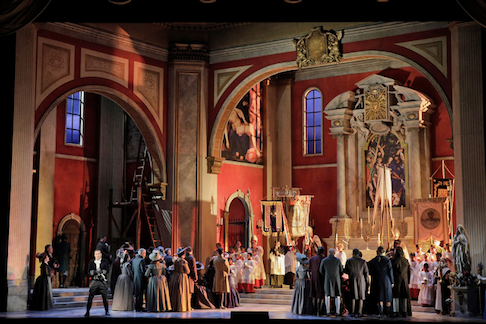 The Te Deum
The Te Deum
British designer Robert Innes Hopkins obliged with a first act set that cannily caught the details of the austere spaces and the coldness of Rome’s St. Andrea della Valle (in spite of the vivid red wall) but focused his space into a corner where the story could begin in its sordid detail. The Palazzo Farnese of the second act took place not in a grand room of state but in a messy, lesser room, once again in a corner perspective for intimacy. The palace’s Renaissance grandeur was marred by the detail of an art nouveau facade of a shadow box side-room (yes, the torture room!). The upward swirl of the Sant-Angelo fortress was topped by its sword-bearing Bernini-esque statue (brutal Renaissance art works were a visual focal point in each act).
The Bernini statue however hid our view of a presumed Tosca leap from the heights of the fortress — the final abnegation of the Tosca ritual that had been enacted 175 times on the War Memorial stage over the past 95 years. Tosca herself of this iconic operatic ritual is a diva, and we’ve seen absolutely every great Tosca of opera’s golden era (except Maria Callas who canceled) leap the thirty feet from the top of the old Agnini/Bosquet set to the War Memorial floor. Until now.
Our current Tosca, Italian soprano Carmen Giannattasio is not a diva, rather she is a Roman soprano who has caught the fancy of a lusty Roman policeman, Scarpia, American baritone Scott Hendricks, who made the “hard pulse of his arousal” quite apparent. Cavaradossi, American tenor Brian Jagde, is a good-spirited painter who unfortunately is involved a bit in politics, and has a young friend, Angelotti who was beat up by partisan thugs. These were real people, made real, in fact, because they were excellent singers, and could be, possibly, exactly who they are.
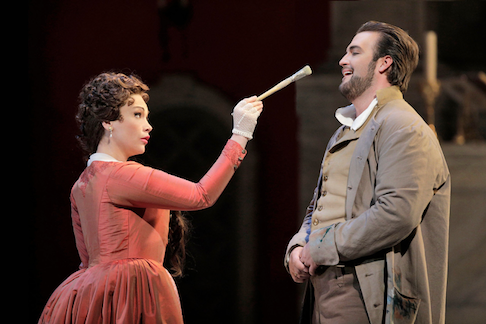 Carmen Giannattasio as Tosca, Brian Jagde as Cavaradossi
Carmen Giannattasio as Tosca, Brian Jagde as Cavaradossi
Of course it was Puccini’s Tosca and that too was always apparent, and this was the magic of the production. Tenor Jagde delivered his two arias with a delicacy of feeling and a mastery of Italianate technique that I did not know he possessed. Soprano Giannattasio gave her great aria supine on the stage floor, and scaled the many heights of the role with a convincing bel canto lyricism that comfortably rode Puccini’s verismo. Baritone Hendricks exposed his desire in true bel canto (say what you want but say it beautifully) and simultaneously convinced us of its urgency. Bass-baritone Hadleigh Adams’ Angelotti was sonorous, made even more operatic by his operatic limping (not always the same leg).
Further intelligence about the production: the voices of the boy acolytes of the first act were amplified by the voices of their mothers, perhaps present to protect the boys from predators (hardly Dale Travis’ ageless, sweet old sacristan). The first act question we always ask (just who is this Countess Attavanti?) was finally answered — she showed up at the end of Scarpia’s Te Deum, was abducted by Scarpia’s thugs, and reappeared looking a bit used when the second act curtain opened onto Scarpia’s office. Tosca did fortify herself with a gulp of wine after murdering Scarpia, placing but two candles by his lifeless body to the absolutely eery, creepy music rising from the pit. The faraway shepherds music of the third act was enacted by boys atop Sant’Angelo who cutely pretended to be soldiers executing one of their own.
We were gripped by the story, and satisfied by the singing. It was an auspicious debut of the Tosca set that we will see in countless editions, possibly throughout the remainder of this century. Catch it while it’s fresh.
Michael Milenski
Cast and production information:
Floria Tosca: Carmen Giannattasio; Mario Cavaradossi: Brian Jagde; Baron Scarpia: Scott Hendricks; Cesare Angelotti: Hadleigh Adams; A sacristan: Dale Travis; Spoletta: Joel Sorensen; Sciarrone: Andrew Manea; A shepherd boy: Miles Kaludzinski. Chorus and Orchestra of the San Francisco Opera. Conductor: Leo Hussain; Stage director: Shawna Lucey; Production designer: Robert Innes Hopkins; Lighting designer: Michael James Clark. War Memorial Opera House, San Francisco, October 11, 2018.
image=http://www.operatoday.com/Tosca18_SF1.png
product=yes
product_title=Tosca in San Francisco
product_by=A review by Michael Milenski
product_id=Above: Carmen Giannattasio as Tosca, Scott Hendricks as Scarpia [All photos copyright Cory Weaver courtesy of San Francisco Opera]
October 12, 2018
Fine performances in uneven War Requiem at the Concertgebouw
The War Requiem is monumental in scale but highly personal in nature. Britten wove a selection of poems by Wilfred Owen into the Roman Catholic Mass for the Dead, translating resonances between the two texts into graphic musical descriptions. The trumpets of the last judgment become bugles harrying soldiers to their death. In the Offertorium he seizes upon the reference to “Abraham and his offspring” to use a poem in which Abraham, unlike in the Bible, does sacrifice his son Isaac “and half the seed of Europe, one by one.” The orchestra never lets us forget that we are in the midst of a massacre: shells wail, canon booms, and bells toll for the dead. Dissonance, especially the persistent use of a jarring tritone, permeates the tonal foundation of the work with unease. Amidst the doubt and despair, a children’s choir points to hope and regeneration.
For the world premiere in 1962, at the consecration of the new Coventry Cathedral, the soloists were to symbolize peace between old enemies: a Russian soprano, a British tenor and a German baritone. Because the Soviet authorities denied Galina Vishnevskaya permission to travel, Belfast-born Helen Harper ultimately sang alongside tenor Peter Piers and baritone Dietrich Fischer-Dieskau. The nationalities of the soloists at the Concertgebouw, soprano Elena Stikhina, tenor Mark Padmore and baritone Michael Volle, mirrored Britten’s original idea. However, despite this superior trio of soloists, three choirs with an excellent track record and the RCO, the performance lacked overall dramatic charge. Britten divides his titanic forces into three units occupying different sections of the stage. The soprano solo, choir and large orchestra perform the Latin mass, the tenor and baritone sing Owen’s poetry with a chamber orchestra, and a boys’ choir performs parts of the liturgical text accompanied by an organ. Noseda had the last two groupings in hand, but failed to retain tension in the first one.
Refulgent brass fanfares notwithstanding, the main choral passages did not gel. The balance was off-kilter, with the Netherlands Radio Choir and Flemish Radio Choir often overpowering the orchestra. Their first entrance on the initial Requiem aeternam was far too loud, presaging the lack of dynamic finesse that dogged the performance. Noseda seemed to favor sudden fortes over nuanced dynamic build-ups. The women’s voices at the start of the Recordare should emerge ethereally from the mist and smoke. Instead, they just showed up. Even the exultant “Hosanna in excelsis” that bursts from a cacophony of choral murmurs in the Sanctus was not what it could have been. Although tonally pleasing, the chorus, atypically, also lacked textual bite, depriving the serrated Dies irae of its full, rapid-fire impact. Fortunately, Elena Stikhina, singing from the back of the stage, repeatedly came to the rescue with her gleaming, sovereign soprano. Cleanly vaulting across the wide intervals of the Liber scriptus and precisely fluent in the sinuous Sanctus, she delivered one gorgeous solo after another.
In the poems sung by the two soldiers from opposing sides, the performance soared to a higher level. From baleful double bass to puckish woodwinds, the twelve-piece ensemble played exquisitely, in complete flow and fusion with the soloists. Padmore and Volle did justice to the searing poems as only first-rate song recitalists can. With a hundred hues and shades, Volle tapped into the tragedy of wasted lives and lost happiness. His narratives were taut with restrained anger, uncoiling in his last solo on the words “I am the enemy you killed, my friend”. Padmore was the electric center of the performance, making every moment count. Noble and urgent, he captured the desolate pathos of the piece, nowhere more piercingly than in “Futility”. The National Kinderkoor, a mixed children’s choir instead of the boys’ choir prescribed in the score, was another outstanding asset. Articulating the text with exemplary clarity, they personified the mellifluous voice of innocence. At their entrance with a pointed Domine Jesu Christe during the Offertorium it was as if fairy lights came on.
The three divisions only perform simultaneously in the final section, the Libera me, when a shuddering choral ensemble gives way to the meeting between the two dead soldiers and then a whispered In paradisum. It is here that Noseda finally stretched a strand of sustained tension. Chorus and orchestra settled into a happier sound balance, bringing the evening to a satisfying conclusion. Given the aggregate talent on display, there is no reason why the two repeat performances should not be of the same quality from start to finish.
Jenny Camilleri
Britten: War Requiem
Elena Stikhina, soprano; Mark Padmore, tenor; Michael Volle, baritone. Conductor: Gianandrea Noseda. Netherlands Radio Choir. Flemish Radio Choir. Nationaal Kinderkoor. Royal Concertgebouw Orchestra. Heard at the Concertgebouw, Amsterdam, on Thursday, 11th of October, 2018.
image=http://www.operatoday.com/Noseda.png image_description=Gianandrea Noseda [Photo courtesy of www.gianandreanoseda.com] product=yes product_title=Fine performances in uneven War Requiem at the Concertgebouw product_by=A review by Jenny Camilleri product_id=Above: Gianandrea Noseda [Photo courtesy of www.gianandreanoseda.com]October 4, 2018
The Tallis Scholars at Cadogan Hall
The evening’s full complement of fourteen singers opened with John Taverner’s six-part Magnificat, ably, convincingly reconstructed from the parts that remain. Plainsong roots were evident – that is, after all, how it opens – as was the great musical flowering, both in work and performance, from that most fertile of soil. Melismatic duetting sopranos and tenors on ‘eius’, the whole choir likewise on ‘suo’: detail was attended to without exaggeration. The greater unfolding was, unsurprisingly, the thing, however. ‘Sound’ did not especially vary; textural variety spoke for itself, Taverner’s ornate doxology culminating in a radiant ‘Amen’.
William Cornysh’s Ave Maria– not the familiar text – perhaps sounds more ‘austere’ to our modern ears, closer to its mediæval past, not least in terms of harmonic relationships. Such would hardly be surprising, given its earlier date of composition. Yet it speaks – and here, in performance, spoke – just as clearly, if differently. Just as much ‘happens’, so long as one listens. John Brown’s Stabat Matersounded, rightly or wrongly, somewhere in between: as much, I think, a matter of programming as of material. It flowed beautifully, sadness lying in the words rather than in any Romantic, ‘emotional’ sense. Antiphonal passages – such as that between soprano and bass parts, ‘Quis non potest contristari…’ – caught the ear and, more important, returned us to experience and contemplation of the celebrated poem. Nevertheless, the cries of ‘Crucifige, crucifige’, if hardly Bachian, seemed to echo through the ages with the accumulated weight of crucified tradition.
Tallis’s Te Deum ‘for meanes’, which opened the second half, immediately sounded very much of ‘our’ Anglican tradition, even thought that requires more than a little backdating. Its English text is one thing, of course, but its directness, its interplay between ‘dec’ and ‘can’ (the two sides of the choir’), its harmony, and much else had it sound more modern than perhaps it is. One drew parallels, of course, not least points of detail – false relations, for instance – with what had gone before, but it was a different church, a different Church too, brought forth in one’s visual as well as aural imagination. Might it have been performed with a little more drama? Yes. Should it have been? Perhaps. Again, however, there was much to glean from the gentle, informed respect with which these voices and their director brought it to life.
Cornysh’s Gaude virgo mater Christiseemed to offer merely in its notes something a little more – this is highly relative – of a lament. Our conceptions of what ‘fits’ a text, however, are not necessarily those of a fifteenth-century composer. It would be mightily strange if they were. The music once again drew us in to the text, another hymn of praise to the Virgin. Two works by John Sheppard concluded the concert. The Compline alternation of chant and polyphony founded upon it in Sheppard’s Jesu salvator saeculiyielded subtle secrets, not least in the surprising – so long as one listened! – final ‘Amen’. The Marian votive antiphon, Gaude virgo Cristiphera– according to James M. Potter’s helpful booklet note, the only example we have from Sheppard – took longer, considerably longer over its words, offering a radiant sense of culmination. This, one felt, was a world of wonders almost yet not quite vanished. The more we listened, the more we shared in it: quite right too.
The encore, Purcell’s Hear my Prayer, still sounds very much ‘with us’: too much so, some might argue, accusing us of sentimentalising. So be it; those grinding dissonances implored as few harmonies can. The English Orpheus will always be with us; so too will his predecessors – as, indeed, will his successors. Why choose?
Mark Berry
Programme:
Taverner: Magnificat a 6; Cornysh: Ave Maria; Browne: Stabat Mater; Tallis: Te Deum ‘for meanes’; Cornysh: Gaude virgo mater Christi; Sheppard: Jesus salvator seculi; Gaude virgo Christiphera. Tallis Scholars, Cadogan Hall, London, Tuesday 2 October 2018.
image=http://www.operatoday.com/Tallis%20Scholars%20Nick%20Rutter.jpg image_description=The Tallis Scholars with Peter Philips (centre) [Photo by Nick Rutter] product=yes product_title=The Tallis Scholars at Cadogan Hall product_by=A review by Mark Berry product_id=Above: The Tallis Scholars with Peter Philips (centre)Photo by Nick Rutter
Dido and Aeneas: Academy of Ancient Music
I recently discussed with director Thomas Guthrie his plan - initially proposed by AAM director Richard Egarr - to precede the presentation of Purcell’s Dido and Aeneas with the staging of Dido’s funeral, accompanied by a selection of the composer’s instrumental and vocal music, so it was no surprise when the black figures of the AAM Chorus processed soberly onto the platform and, observing courtly protocol, heralded the ritual with unison drum-thumps of almost violent portent. The careful peeling back of the delicate shroud revealed a fragile white form - a vulnerable, delicate, ethereal figure, seemingly far removed from the tragic queen of history and myth.
Perhaps this was Guthrie’s ‘point’: “Remember me,” she urges, but who is ‘me’? Who was/is Dido: a tragic victim of Fate destroyed by imperial destiny, or a real flesh-and-blood woman betrayed and abandoned by a lover for whom god-ordained purpose outweighs private passions? Moreover, how should we ‘remember’? Should we lament, pity and commemorate, sustaining a memory of the dead in the land of the living, as the final chorus of the opera counsels and as the AAM Chorus here observed: ‘Soft and gentle as her heart, / Keep here your watch and never part’? Or does Dido advocate not merely pity, but vengeance?
Certainly, as Rowan Pierce’s Belinda and Ashley Riches’s Aeneas stood beside the wraith-like effigy there was a palpable anger to their grief, and a sense of imminent confrontation and conflict. This strength of feeling was, however, strangely at odds with the intimate gentility of the musical discourse. Leader Bojan Čičič, violinist Rebecca Livermore and viola da gamba player Imogen Seth-Smith played the first three movements of Purcell’s Sonata in G minor with immensely touching refinement, but the intimate quietude transported us to the realms to which Dido had departed, distancing us from the more visceral emotions of those present at her funeral. The Barbican Hall seemed too large and ‘open’ a venue for such private concerns.
Pierce sang ‘So when the glittering Queen of Night’, from Orpheus Britannicus, from the shadows and with moving clarity and sensitivity, accompanied by theorbo and plaintive strings, but from my front stalls seat I wondered whether her tender pianissimo carried to the uppermost tiers of the Barbican Hall. There was more animation in the Chacony in G minor Z730, during which Riches prowled and scowled; the Pavan in G Minor (in which Čičič and Seth-Smith were joined by Persephone Gibbs) offered delicate though somewhat distanced musing.
The most direct impact was made by the AAM Choir whose voices, in ‘No stars again shall hurt you form above’ from The Tempest, circled the instrumentalists, blending with unaffected sweetness. A cushion of softly brushed theorbo strumming accompanied Pierce and Riches in ‘Close thine eyes and sleep secure’, inviting us into the intimacy of grief: their declaration that “The music and the mirth of kings/ Are out of tune unless she sings” rang with painful truth. The rites were brought to a close with Purcell’s Chacony in G minor Z807, conducted by Egarr with inspiring energy and with, literally, his whole being. After the anguish of so much unalleviated G minor, the final tierce de Picardie was something of a relief.
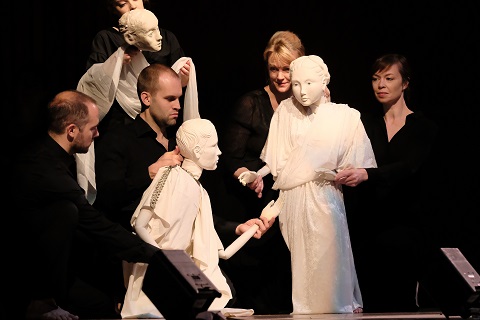 Dido and Aeneas, Academy of Ancient Music. Photo Credit: Mark Allan.
Dido and Aeneas, Academy of Ancient Music. Photo Credit: Mark Allan.
And, so, in the second half of the concert we looked back to the events which had resulted in such doleful rites and woe. There has been considerable debate over the ‘politics’ of Dido and Aeneas: the nature and degree of the opera’s engagement with the troubling years of the Stuart monarchy, as well as still unresolved problems relating to the dating and chronology of performances and sources. But, Guthrie, despite declaring his belief that Dido is “clearly related in the 17th -century mind to Elizabeth I (‘Elissa dies tonight’)”, seemed here to eschew a search for a topical allegory in his filtering of the very human, and diverse, emotions of the opera through puppets - avatars which rather restricted the range of the drama’s passions and abstracted them from any specific or inferred context.
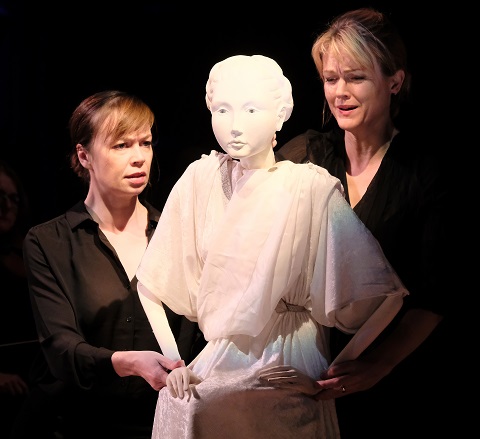 Laura Caldow (puppeteer) and Caitlin Hulcup (Dido). Photo Credit: Mark Allan.
Laura Caldow (puppeteer) and Caitlin Hulcup (Dido). Photo Credit: Mark Allan.
I worried whether the fragile, translucent puppet-Dido - touchingly slight and subtle - could actually bear the tragic weight of the Queen’s Fate. Though expertly manipulated by soprano Caitlin Hulcup and puppeteer Laura Caldow, in the final reckoning I felt that ‘she’ could not. However, that’s not to say that the tiny quiver of jaw, delicately pained expression and poignant hinterland gaze of this Other-monarch were not affecting. And, if there was a restriction of expressive range and a sense of emotional secrecy, then this was perhaps apt. For the Queen of Carthage remains a mystery to us: her public destiny seems to conflict with her private feelings, the latter remaining elusive and incompletely understood - as she tells Belinda, her grief ‘admits of no revealing’.
But, where was the anger that the queen hurls at her betrayer, the anguish of confession publicly displayed in the lamentation with which she submits to the darkness and death that shade and invade her? Purcell draws us into his characters’ self-doubts and divisions, but this Dido-puppet retained an air of formality and detachment, her inner life hidden from public view. However, Caitlin Hulcup’s smooth, plush mezzo did communicate the queen’s struggles, conflicts and uncertainties. Dido’s dying lament tugged against the unrelenting ground bass, and at our heart-strings, shining with a velvety richness that seemed at odds with the insubstantial, brittle figure so carefully lain upon the earth by Hulcup and Caldow.
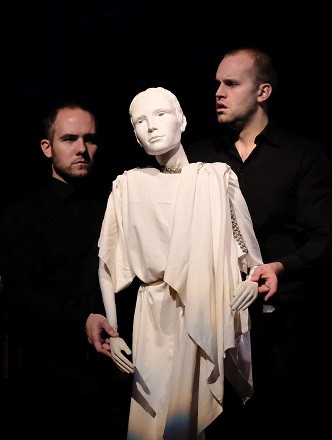 Photo Credit: Ben Thompson (puppeteer) and Ashley Riches (Aeneas). Photo credit: Mark Allan.
Photo Credit: Ben Thompson (puppeteer) and Ashley Riches (Aeneas). Photo credit: Mark Allan.
Like Hulcup, Ashley Riches was assisted by a puppeteer, Ben Thompson, though both singers showed astonishing adeptness in manipulating their self-representing avatars all the while singing with focus, sensitivity and character. Riches brought a lovely tenderness to Aeneas’s pleas and avowals, which complemented the gentle lowering of the puppet’s gaze and cautious reaching out of its slender arms, though it was hard to imagine this Aeneas as an authoritative warrior-leader torn from his queen by the fulfilment of his Roman destiny. It was also difficult to imagine or sense any ‘real’ attraction between the two lovers, though William Carter and Eligio Luis Quinteiro did their best to conjure passionate frissons with the vibrant jubilations of their baroque guitars as the queen and her suitor departed for their tryst in the cave.
Rowan Pierce was superb as Belinda, conveying the lady-in-waiting’s vivacity, directness and integrity through both her dramatically sensitive phrasing and the way in which she bestowed her puppet-mask with a freedom of movement. As the Second Woman, soprano Charmian Bedford communicated a corresponding spiritedness. Blackly draped and illuminated with a piercing blue hue, Neal Davies was a vivid and surprisingly earthy Sorceress, while counter-tenor James Hall posed as the false Mercury, issuing his divine command from behind a mask, in the rear doorway of the platform.
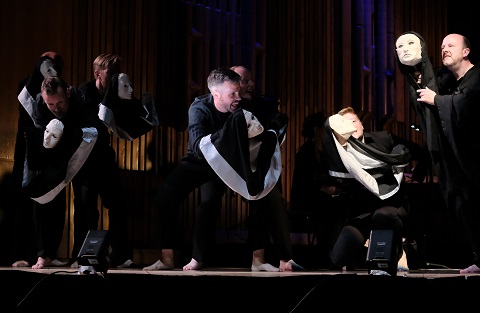 Choir of the Academy of Ancient Music. Photo Credit: Mark Allan.
Choir of the Academy of Ancient Music. Photo Credit: Mark Allan.
While Michael Casey’s pointed lighting brought the subtleties of the solo-puppet’s visages to the fore, the Chorus, their masks trailing sinuous scarves, sometimes slipped into the shadows as they moved around, behind and through the instrumentalists, the puppets losing definition amid the swirling trains. Interestingly, only when the chorus abandoned their masks for a rip-roaring, hop-skipping sailor’s jig did one feel the full directness and life-spirit of Purcell’s music, though, even here Guthrie and designer Ruth Paton denied us any visual colour.
That said, some of the best singing of the night came from the AMM Choir. Indeed, if we remained distanced from the blanched puppet-protagonists, then this placed the glories of the music itself centre-stage. Egarr led his musicians with dynamic gusto, leaping to his feet to whip up instrumental rejoicing and tempests, moving to the front to join the Witches’ Chorus in their gleeful revelling, “Destruction’s our delight”, shaping the tempos and phrasing with natural ease and control.
The drooping phrases of the final chorus unfolded in a seemingly unceasing cycle, making public Dido’s inner life in a perpetual appeal to the Cupid’s to “scatter roses on her tomb”, a petition which, like our remembrance, would and will never cease.
Claire Seymour
Purcell: Sonata No.1 in G minor (movements 1, 2 and 3), ‘So when the glittering Queen of Night’ (Orpheus Britannicus), Chacony in G minor Z730, Pavan in G minor, ‘No stars again shall hurt you from above’ ( The Tempest), ‘Close thine eyes and sleep secure’, Chacony in G minor Z807, Dido and Aeneas.
Dido - Caitlin Hulcup, Aeneas - Ashley Riches, Belinda - Rowan Pierce, Sorceress - Neal Davies, Second Woman - Charmian Bedford, First Witch - Kate Symonds-Joy, Second Witch - Cathy Bell, Sailors - James Geer/Edmund Hastings/Matthew Sandy, Puppeteers - Laura Caldow/Ben Thompson; Director - Thomas Guthrie, Music Director/harpsichord - Richard Egarr, Lighting - Michael Casey, Designer - Ruth Paton, Choir and Orchestra of the Academy of Ancient Music.
Barbican Hall, London; Tuesday 2nd October 2018.
image=http://www.operatoday.com/AMM%20Dido%20title.jpg image_description= product=yes product_title=Dido and Aeneas: Academy of Ancient Music at the Barbican Hall product_by=A review by Claire Seymour product_id= Above: Laura Caldow (puppeteer), Caitlin Hulcup (Dido) and Rowan Pierce (Belinda)Photo credit: Mark Allan
October 3, 2018
Poignantly human – Die Zauberflöte, La Monnaie
It is thus ideally suited to Romeo Castellucci's intelligent, literate approach, with multiple layers of symbols, not all of which might be obvious at first, but become more rewarding with each viewing. His sets are elegant but don't operate on appearance alone. Castellucci is a director for those who care enough about opera to make an effort to penetrate beyond the surface. Those who want opera to be "pretty" can be content, but they'll miss out on the real depths. Please read more about three of his recent productions Salzburg Salomé, Munich Tannhäuser, and Henze's The Raft of the Medusa. Like composers, and conductors and artistes, good directors have a vocabulary of their own : the more you experience, the more patterns emerge.
Castellucci's approach to Die Zauberflöte is illuminating on many levels, a term which has more meaning in this case than usual, since illumination is a concept at the core of Freemason beliefs. Freemasons are "The Sons of Light", light meaning enlightenment, self-awareness and understanding an individual's place in a community. Members undergo rites of initiation, facing challenges as they rise within the hierarchy. Until very recently, secrecy was also part of the Freemason ethos, further emphasising the concept that wisdom comes not as an automatic right for everyone, but only to those who make the effort to seek it out. Elitist perhaps, but that kind of elitism is no bad thing.
Thus the Overture is played over a dark set where a man faces a single line of light and tries to grasp it. Other men appear, in strange non-human regalia, with a sheet of coloured cloth. It's evidently a reference to something, though one I don't get, which is part of the fascination of Castellucci productions : you don't need to know everything first time round, which in itself is the beginning of wisdom. The darkness remains, but now is backdrop to props and costumes of lustrous whiteness: singers and actors move like dolls in an elegant music box, seen through a haze of fine gauze. Rococo elaboration against classical formality. For more detail about the set design, as beautiful as icing on a wedding cake, please see HERE. The singers move in symmetrical patterns, suggesting at once the intricate layers in the plot and the idea that the characters’ fates are controlled by forces beyond their control. The moon, the sun, the movement of planets in the universe and the traverse of time. Lots of feathers, too, evoking nature and the birds, and Papageno (Georg Nigl) whose job it is to trap and kill. In Die Zauberflöte the Queen of the Night (Sabine Devieilhe) pits her wits against Sarastro (Gábor Betz) and his confrères. Men versus women, an undercurrent that runs through the piece, which Castellucci, with his appreciation of the "Eternal Feminine", knows how to develop.
Thus the interlude between the first and second acts, separating the silvery night from golden day. At first, the impersonal "song" of machines : three women are seen using breast pumps. Real women, who lactate. the contrast between this intimate act of selfless nurturance and the hollow drone of the machine makes a point. As the real music starts the milk is poured into a long tube - the tube which represented light right at the beginning. This makes sense connected to Sarastro's aria "O Isis und Osiris" which follows, which is an invocation to protect those starting out on their journey ahead. Castellucci then inserts spoken dialogue which also should not shock, since dialogue is part of the Singspiele tradition. Women and men on two sides of the same stage, costumed as anonymous androgynes. As they tell of the challenges they have faced in their lives, they become individual, with personalities and backgrounds. Compelling testimonies about coming to terms with blindness and disfigurement. Many of these speakers are in fact real people, not actors, and they've faced challenges most of us may (hopefully) never meet. So anyone in the audience who can't face these brutal truths therefore fails the challenges placed before them. "We have passed through the Night. We are very close to freedom". So don't anyone dare knock this scene or sneer at their courage, and Castellucci's decision to let them speak. The reason the dialogue is in English is, I think, because the speakers come from different countries, but are united by experience - another concept important to this drama.
More gold - more "light"- but androgyny still prevails, since enlightenment is not yet achieved. Georg Nigl's robust Papageno provides comic relief, of a sort, but the silvery tomes that accompany his song suggest the silvery tones of the night. For much the same reason, the Three Knaben represent immaturity. They have the innocence of birds, for they have not experienced challenge. Tamino (Ed Lyon) and Pamina (Sophie Kärthauser) will, however, grow up in the course of the time as they face their destiny. Different couples - professional singers and amateur speakers - are seen interacting together, coming to "know" each other and themselves. More symmetry still, and almost painful vulnerability. A blind woman lets herself be touched, respectfully, by men whose hands are maimed : she has learned to trust, not to judge. Would that more audience dared the same ! Then another surprise - the Narrator (Dietrich Henschel) speaks He finds himself alone. "I am not myself, but still myself. I have crossed another horizon", he says "But I have you, silvery light, victorious over fire". He calls out the individual names of the non-professional speakers, who surround him, some of whom are burns victims. "You are the truth for me - you re-assure me". Thus the bird-like freedom and innocence of the Papageno-Papagena duet that follows and the joyous ensemble, where all are united, women and men, Night and Day, mortals and (possibly) immortals. "Heil sei die Geweihten! Ihr dräget durch Nacht!.....Es siegt die Stärke und Krönet zum Lohn die Schönheit und Weisheit mit ewiger Kron". A fine cast all round, conducted by Antonello Manacorda, worthy of the challenges of this visionary yet powerfully human production. Those who can cope with challenge can catch it here on arte.tv.
Anne Ozorio
image=http://www.operatoday.com/de-munt-mzc4nti0mji2mq.png
image_description=© Adam Fuss / Xavier Hufkens Gallery
product=yes
product_title=Poignantly human – Die Zauberflöte, La Monnaie
product_by=A review by Anne Ozorio
product_id=Above © Adam Fuss / Xavier Hufkens Gallery
October 2, 2018
Covent Garden: Wagner’s Siegfried, magnificent but elusive
Keith Warner’s production, however, remains somewhat troubling; one can spend more time trying to unravel the allusions, the meanings behind the clutter, the complex perceptions of comedy and tragedy than would be wise for any sane man.
Der Ring Des Nibelungen is all about interconnectivity and Warner’s direction attempts to establish this, even in esoteric ways. The toy aeroplane from Das Rheingold, for example, is transformed in Siegfried as the curtain rises into the wrecked fuselage of a stripped down, much larger aeroplane. As with much of the imagery here it’s symbolic - just as a sword rises from a wrecked pram during the Vorspiel, so Wotan, disguised as the Wanderer, does so from the broken shell of the cockpit. But why there should be an aeroplane here at all is quite another question. As with much of Wagner, time is constantly in a state of flux; motifs come and go, and Warner does the same with his imagery. Act III of this Siegfried floats moving clouds against a wall but it’s the perspective that is different and looks back towards Act I. Rather than looking two-dimensional, the angle gives the impression of floating through clouds, rather as you’d experience from a plane as we recall the wreckage from earlier. For a fleeting moment, you’re reminded of Leni Riefenstahl’s Triumph of the Will. The sprawling algebraic equations before Act I begins make little sense - both as to their meaning and why they should be there - but when we get to Act II, as Siegfried confronts Fafner, the Tarnhelm itself is nothing but an algorithmic Rubik’s Cube.
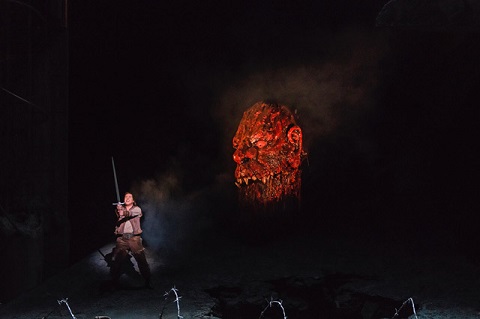 Stefan Vinke as Siegfried. Photo Credit: Bill Cooper.
Stefan Vinke as Siegfried. Photo Credit: Bill Cooper.
Paradoxes abound in Siegfried. It’s a comedy within a tragedy; it’s about the transition of the world of Wotan and the Gods into the redemptive vision of love he has for Siegfried and Brünnhilde, the old order giving way to a new order. If the downfall of the Gods is seen as inevitable, the calamity that will become the tragedy of the final opera isn’t foreseen. Warner’s take on this in Siegfried isn’t really clear - other than the biggest paradox of all in that Wotan is placing his faith for a new future in a Siegfried who is clearly unsuitable.
The comedy in this Siegfried is surprisingly restrained. Warner takes a notably neutral standpoint characterising his Mime, for example. Gerhard Siegel, returning to this production, is magnificent, both vocally and dramatically. Balance becomes an art form in his purely theatrical characterisation of the role - in no sense could one suggest this is a caricature of the part, as can so easily happen. Warner makes a distinction between comedy and making his Mime a clown - Siegel is every part a malevolent dwarf, part mad scientist, as untidy and living amid his clutter as he is scheming and hollow of emotion. He howls, groans, screams and whines. He’s intemperate and evasive. Siegel’s long scenes with Stefan Vinke’s Siegfried are wonderfully complementary: There is a real sense of spontaneity between these two singers, and the humour unfolds without feeling forced.
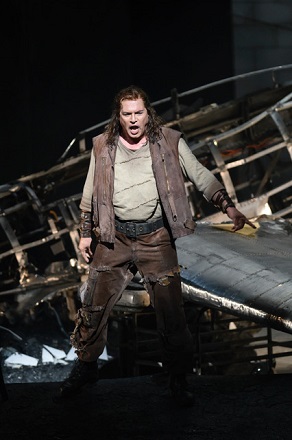 Stefan Vinke as Siegfried. Photo Credit: Bill Cooper.
Stefan Vinke as Siegfried. Photo Credit: Bill Cooper.
Stefan Vinke’s Siegfried is so extraordinarily convincing - this is after all the 100th time he has sung the role - you often feel he is the Siegfried of our time. With his patched-up army fatigues and leather battle vest, there is a punkish, roguish side to him that Warner is more than willing to explore. There is a boundless energy to this Siegfried - he hops over discarded mattresses, jumps back and forth over barbed wire fences and brandishes his newly forged sword like a warrior. He’s as crusty as he is anarchic; but there is a seething unpretentiousness and innocence as well. One minute he is cracking an egg over Mime’s forehead; the next he is forging his sword. He transforms from a boy into an all-knowing grease-monkey who can work the aeroplane’s propellers to set the forge working and attach pumps to fuel the flames. Does Warner make this all seem incredulous? Well, yes, he does. This Siegfried seems entirely schizophrenic. On the other hand, this is a Siegfried who is all but immune to any manifestation of physical danger or fear. Siegfried’s battle with Fafner, and his transformation into a dragon, might be considered partly comic - but Warner makes Vinke’s Siegfried take his cue from Wagner’s music, with all the darkness it portrays, rather than the literal humour the libretto suggests.
But Vinke’s Siegfried is another paradox in this production too. The heroism of Act II at the foot of Fafner’s cave is a correction to the beguiling innocence of his woodland scene with Heather Engebretson’s acrobatic Woodbird. But innocence can easily become petulance; he becomes frustrated by his inability to make a sound from the reed he has made. In Act III, Warner completely subverts the balance of love versus power that Wotan has imagined for Siegfried and Brünnhilde. This isn’t exactly a vision of Siegfried who will emerge from the Volsungs to triumph over the power of the Gods. Siegfried the punk is too radical to embrace the concept of love - his reticence as he awakens Brünnhilde is borne of childlike shyness. Even the lighting of this scene cleverly suggests it’s full of apprehension and unknowingness. Warner literally tosses the concept of love into the flames. But even when Nina Stemme’s magnificent and imposing Brünnhilde emerges we don’t get the inklings of a consummation but a game of cat-and-mouse. Warner keeps them apart, on opposing sides of a grey wall. They are literally and figuratively a world apart, Brünnhilde’s ecstatic dialogue - so searingly sung by Stemme - almost falling on Siegfried’s deaf ears. As Siegfried throws himself onto Brünnhilde at the opera’s very end it’s as charmless as the filthy mattress itself.
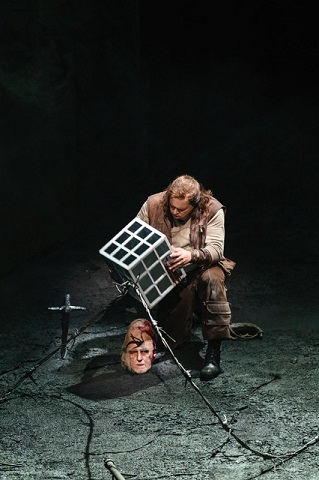 Brindley Sherratt as Fafner and Stefan Vinke as Siegfried. Photo Credit: Bill Cooper.
Brindley Sherratt as Fafner and Stefan Vinke as Siegfried. Photo Credit: Bill Cooper.
Even withstanding the complexity of ideas in this production, and the somewhat wilful direction, there is much that stands out as exceptional. You can never escape the underlying tension and anger that characterises much of this Siegfried: I lost count of the number of times a chair was thrown somewhere around the stage. Antonio Pappano’s gripping conducting of the score is so extraordinarily visual, so seismic and visceral at times, that it mirrors the staging to perfection. His pacing of the score may be fast for some listeners but it seemed near-perfect to me. Only briefly, notably in Act II, did the outstanding Royal Opera House Orchestra wobble or have issues with intonation. Vinke’s hammering in the Act I forging scene is breathtakingly musical and is replicated in the timbre of the orchestra, too; it is not always like this in staged performances of Siegfried. I don’t think I’ve ever seen a more dramatic Vorspiel than the one we got to the opening of Act III. Pappano’s very brisk, fiery tempo was electrifying, but combine this with Wotan angrily tossing a mattress and whatever else he could get his hands on from a rotating platform and the effect was unforgettable. If the earth goddess Erde being wheeled in on a high throne seemed perhaps a touch clumsy, the orchestra was as dark as Wiebke Lehmkuhl’s gorgeously plush voice. John Lundgren’s Wanderer had every reason to struggle while singing on a revolving platform but he didn’t. The voice remained as rich, dark and focused as it had from his first appearance in Act I. His Riddle Scene with Mime was full of mystery. Johannes Martin Kränzle’s Alberich resonated evil, and Brindley Sherratt’s Fafner had a dark tone that cracked like thunder.
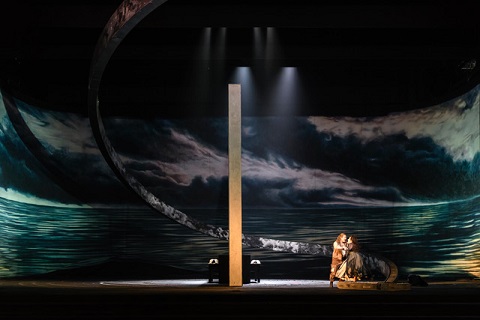 Nina Stemme as Brünnhilde and Stefan Vinke as Siegfried. Photo Credit: Bill Cooper.
Nina Stemme as Brünnhilde and Stefan Vinke as Siegfried. Photo Credit: Bill Cooper.
Nina Stemme’s Brünnhilde has grown into one of the great dramatic performances. It isn’t just that the voice has such tremendous range, it’s now that she believes entirely she can equal the complexity of the role. The evenness of tone, the ability to be both lyrical and dramatic is very impressive. She fortunately lacks the hardness of inflection that sometimes marred a Nilsson performance - Stemme’s Brünnhilde is quite notable for being exceptionally warm in tone, but she is equally merciless in keeping the line clean.
Stefan Vinke’s Siegfried is simply peerless. Casting Siegfried is always a problem but Vinke has everything you could ask for in a great Siegfried. Certainly, when I heard him take on the part early in his career there were times you felt he lacked the stamina to see it through; that is unquestionably not the case today. That he had such reserves of power to give with Stemme such an overwhelming final duet was remarkable. So much of Siegfried lies in the higher part of the voice that it’s easy for a tenor to become lazy but Vinke has a laser-sharp power to his upper range which enables him to sustain a note effortlessly. Nothing felt clipped; you didn’t feel that there were any shortcuts. There is also beautiful clarity and tonal richness to this voice as well - it’s honeyed, golden, entirely even for a Wagner tenor. I think I’d be hard pressed to hear a better performance of Siegfried from anyone else than the one we got here.
From a vocal, musical and artistic point of view this Siegfried was one of the great evening’s at Covent Garden in many years.
Marc Bridle
Richard Wagner: Siegfried
Stefan Vinke - Siegfried, Nina Stemme - Brünnhilde, Gerhard Siegel - Mime, John Lundgren - Wanderer, Johannes Martin Kränzle - Alberich, Brindley Sherratt - Fafner, Wiebke Lehmkuhl - Erda, Heather Engebretson - Woodbird; Keith Warner - Director, Antonio Pappano - conductor, Stefanos Lazaridis - Set Designer, Wolfgang Göbbel - Lighting, Orchestra of Royal Opera House.
Royal Opera House, Covent Garden, London; 29th September 2018.
image=http://www.operatoday.com/Stefan%20Vinke%20as%20Siegfried%2C%20Gerhard%20Siegel%20as%20Mime%20%28C%29%20Bill%20Cooper.jpg image_description= product=yes product_title=Siegfried: Royal Opera House, Covent Garden, 29th September 2018 product_by=A review by Marc Bridle product_id=Above: Stefan Vinke as Siegfried and Gerhard Siegel as Mime.Photo credit: Bill Cooper